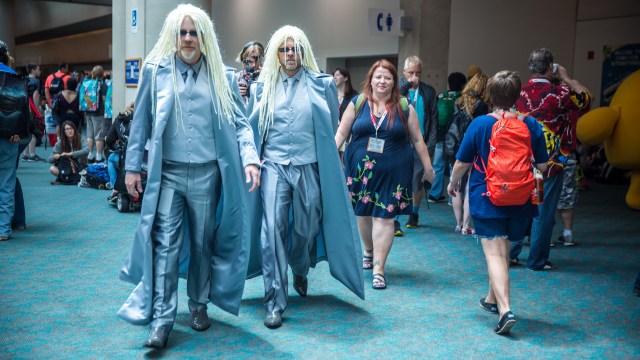Adam invites Alton Brown to join him on an Incognito walk through Comic-Con and check out the exhibit hall. For their disguises, the two choose to portray the Twins from The Matrix Reloaded, coordinating intentionally low-grade costumes to throw off fans. How long will it be before they’re recognized?
Photo Gallery: Collectibles, Cosplay, and ‘Cinephile’ at Comic-Con 2015
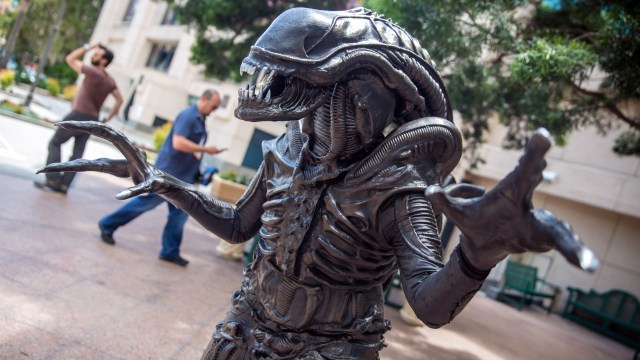


























































































































Photo Gallery: Collectibles, Cosplay, and ‘Cinephile’ at Comic-Con 2015
Photo Gallery: Comic-Con 2015 Cosplay
Phiew, that sure was a Comic-Con. First of all, my apologies to everyone who’s been waiting for a cosplay gallery this year. Between, hosting a party, three Adam Incognito walks, two new Tested projects (one of which we revealed today–The Rancor), and all of our other videos, I just didn’t have the time on the floor last week to shoot enough photos for a proper gallery. Promise to make it up to you at Dragon*Con. But that doesn’t mean I didn’t take any photos. So in lieu of a full cosplay gallery, here’s a selection of my photos showing you my SDCC 2015 experience. A mix of costumes, events, props, panels, and collectibles from Comic-Con, along with my commentary in the captions.
Let’s start with the cosplay that I managed to photograph at the show.
Photo Gallery: Collectibles, Cosplay, and ‘Cinephile’ at Comic-Con 2015
Photo Gallery: Comic-Con 2015 Cosplay
Of all the conventions I get to visit, Dragon*Con has the most inventive cosplay. But the sheer quantity and quality of costumes at Comic-Con dwarves other cons.
Photo Gallery: Collectibles, Cosplay, and ‘Cinephile’ at Comic-Con 2015
Photo Gallery: Comic-Con 2015 Cosplay
I love running into familiar faces of costumers I’ve either photographed before or met at previous conventions. Hendo cosplay is one of the best Spider-Gwens I’ve seen!
Photo Gallery: Collectibles, Cosplay, and ‘Cinephile’ at Comic-Con 2015
Photo Gallery: Comic-Con 2015 Cosplay
A cheerful Galactus in search of a herald.
Photo Gallery: Collectibles, Cosplay, and ‘Cinephile’ at Comic-Con 2015
Photo Gallery: Comic-Con 2015 Cosplay
Phiew, that sure was a Comic-Con. First of all, my apologies to everyone who’s been waiting for a cosplay gallery this year. Between, hosting a party, three Adam Incognito walks, two new Tested projects (one of which we revealed today–The Rancor), and all of our other videos, I just didn’t have the time on the floor last week to shoot enough photos for a proper gallery. Promise to make it up to you at Dragon*Con. But that doesn’t mean I didn’t take any photos. So in lieu of a full cosplay gallery, here’s a selection of my photos showing you my SDCC 2015 experience. A mix of costumes, events, props, panels, and collectibles from Comic-Con, along with my commentary in the captions.Photo Gallery: Collectibles, Cosplay, and ‘Cinephile’ at Comic-Con 2015
Photo Gallery: Comic-Con 2015 Cosplay
Friend of Tested Bill Doran (aka Punished Props!) Bill was part of our special teams crew this year, assisting on the Rancor reveal. Here, he shows off the project he’s been working on: the alien assault rifle replica from District 9.
Photo Gallery: Collectibles, Cosplay, and ‘Cinephile’ at Comic-Con 2015
Photo Gallery: Comic-Con 2015 Cosplay
Mr. Freeze. Frank has talked about wanting to do his interpretation of Mr. Freeze for a while. I really dig the Batman: The Animated Series version…
Photo Gallery: Collectibles, Cosplay, and ‘Cinephile’ at Comic-Con 2015
Photo Gallery: Comic-Con 2015 Cosplay
These Ghostbuster cartoon cosplayers were awesome. That hair!
Photo Gallery: Collectibles, Cosplay, and ‘Cinephile’ at Comic-Con 2015
Photo Gallery: Comic-Con 2015 Cosplay
Couldn’t resist photography a real-life Thorgi.
Photo Gallery: Collectibles, Cosplay, and ‘Cinephile’ at Comic-Con 2015
Photo Gallery: Comic-Con 2015 Cosplay
These two are party of a troupe of Walking Dead cosplayers. Uncanny likenesses all around.
Photo Gallery: Collectibles, Cosplay, and ‘Cinephile’ at Comic-Con 2015
Photo Gallery: Comic-Con 2015 Cosplay
Phiew, that sure was a Comic-Con. First of all, my apologies to everyone who’s been waiting for a cosplay gallery this year. Between, hosting a party, three Adam Incognito walks, two new Tested projects (one of which we revealed today–The Rancor), and all of our other videos, I just didn’t have the time on the floor last week to shoot enough photos for a proper gallery. Promise to make it up to you at Dragon*Con. But that doesn’t mean I didn’t take any photos. So in lieu of a full cosplay gallery, here’s a selection of my photos showing you my SDCC 2015 experience. A mix of costumes, events, props, panels, and collectibles from Comic-Con, along with my commentary in the captions.Photo Gallery: Collectibles, Cosplay, and ‘Cinephile’ at Comic-Con 2015
Photo Gallery: Comic-Con 2015 Cosplay
Phiew, that sure was a Comic-Con. First of all, my apologies to everyone who’s been waiting for a cosplay gallery this year. Between, hosting a party, three Adam Incognito walks, two new Tested projects (one of which we revealed today–The Rancor), and all of our other videos, I just didn’t have the time on the floor last week to shoot enough photos for a proper gallery. Promise to make it up to you at Dragon*Con. But that doesn’t mean I didn’t take any photos. So in lieu of a full cosplay gallery, here’s a selection of my photos showing you my SDCC 2015 experience. A mix of costumes, events, props, panels, and collectibles from Comic-Con, along with my commentary in the captions.Photo Gallery: Collectibles, Cosplay, and ‘Cinephile’ at Comic-Con 2015
Photo Gallery: Comic-Con 2015 Cosplay
Phiew, that sure was a Comic-Con. First of all, my apologies to everyone who’s been waiting for a cosplay gallery this year. Between, hosting a party, three Adam Incognito walks, two new Tested projects (one of which we revealed today–The Rancor), and all of our other videos, I just didn’t have the time on the floor last week to shoot enough photos for a proper gallery. Promise to make it up to you at Dragon*Con. But that doesn’t mean I didn’t take any photos. So in lieu of a full cosplay gallery, here’s a selection of my photos showing you my SDCC 2015 experience. A mix of costumes, events, props, panels, and collectibles from Comic-Con, along with my commentary in the captions.Photo Gallery: Collectibles, Cosplay, and ‘Cinephile’ at Comic-Con 2015
Photo Gallery: Comic-Con 2015 Cosplay
Phiew, that sure was a Comic-Con. First of all, my apologies to everyone who’s been waiting for a cosplay gallery this year. Between, hosting a party, three Adam Incognito walks, two new Tested projects (one of which we revealed today–The Rancor), and all of our other videos, I just didn’t have the time on the floor last week to shoot enough photos for a proper gallery. Promise to make it up to you at Dragon*Con. But that doesn’t mean I didn’t take any photos. So in lieu of a full cosplay gallery, here’s a selection of my photos showing you my SDCC 2015 experience. A mix of costumes, events, props, panels, and collectibles from Comic-Con, along with my commentary in the captions.Photo Gallery: Collectibles, Cosplay, and ‘Cinephile’ at Comic-Con 2015
Photo Gallery: Comic-Con 2015 Cosplay
Bill strikes a pose in his Mass Effect armor in our hotel, right before our Rancor video shoot.
Photo Gallery: Collectibles, Cosplay, and ‘Cinephile’ at Comic-Con 2015
Photo Gallery: Comic-Con 2015 Cosplay
Phiew, that sure was a Comic-Con. First of all, my apologies to everyone who’s been waiting for a cosplay gallery this year. Between, hosting a party, three Adam Incognito walks, two new Tested projects (one of which we revealed today–The Rancor), and all of our other videos, I just didn’t have the time on the floor last week to shoot enough photos for a proper gallery. Promise to make it up to you at Dragon*Con. But that doesn’t mean I didn’t take any photos. So in lieu of a full cosplay gallery, here’s a selection of my photos showing you my SDCC 2015 experience. A mix of costumes, events, props, panels, and collectibles from Comic-Con, along with my commentary in the captions.Photo Gallery: Collectibles, Cosplay, and ‘Cinephile’ at Comic-Con 2015
Photo Gallery: Comic-Con 2015 Cosplay
This Hitman was part of a large group of actors to promote the upcoming game and film.
Photo Gallery: Collectibles, Cosplay, and ‘Cinephile’ at Comic-Con 2015
Photo Gallery: Comic-Con 2015 Cosplay
Phiew, that sure was a Comic-Con. First of all, my apologies to everyone who’s been waiting for a cosplay gallery this year. Between, hosting a party, three Adam Incognito walks, two new Tested projects (one of which we revealed today–The Rancor), and all of our other videos, I just didn’t have the time on the floor last week to shoot enough photos for a proper gallery. Promise to make it up to you at Dragon*Con. But that doesn’t mean I didn’t take any photos. So in lieu of a full cosplay gallery, here’s a selection of my photos showing you my SDCC 2015 experience. A mix of costumes, events, props, panels, and collectibles from Comic-Con, along with my commentary in the captions.Photo Gallery: Collectibles, Cosplay, and ‘Cinephile’ at Comic-Con 2015
Photo Gallery: Comic-Con 2015 Cosplay
A Mad Max, Immorten Joe, and war boys group! I was surprised that there weren’t as many Furiosas as I had anticipated and hoped. But these cosplayers were great!
Photo Gallery: Collectibles, Cosplay, and ‘Cinephile’ at Comic-Con 2015
Photo Gallery: Comic-Con 2015 Cosplay
Immorten Josephine?
Photo Gallery: Collectibles, Cosplay, and ‘Cinephile’ at Comic-Con 2015
Photo Gallery: Comic-Con 2015 Cosplay
Phiew, that sure was a Comic-Con. First of all, my apologies to everyone who’s been waiting for a cosplay gallery this year. Between, hosting a party, three Adam Incognito walks, two new Tested projects (one of which we revealed today–The Rancor), and all of our other videos, I just didn’t have the time on the floor last week to shoot enough photos for a proper gallery. Promise to make it up to you at Dragon*Con. But that doesn’t mean I didn’t take any photos. So in lieu of a full cosplay gallery, here’s a selection of my photos showing you my SDCC 2015 experience. A mix of costumes, events, props, panels, and collectibles from Comic-Con, along with my commentary in the captions.Photo Gallery: Collectibles, Cosplay, and ‘Cinephile’ at Comic-Con 2015
Photo Gallery: Comic-Con 2015 Cosplay
Phiew, that sure was a Comic-Con. First of all, my apologies to everyone who’s been waiting for a cosplay gallery this year. Between, hosting a party, three Adam Incognito walks, two new Tested projects (one of which we revealed today–The Rancor), and all of our other videos, I just didn’t have the time on the floor last week to shoot enough photos for a proper gallery. Promise to make it up to you at Dragon*Con. But that doesn’t mean I didn’t take any photos. So in lieu of a full cosplay gallery, here’s a selection of my photos showing you my SDCC 2015 experience. A mix of costumes, events, props, panels, and collectibles from Comic-Con, along with my commentary in the captions.Photo Gallery: Collectibles, Cosplay, and ‘Cinephile’ at Comic-Con 2015
Photo Gallery: Comic-Con 2015 Cosplay
Phiew, that sure was a Comic-Con. First of all, my apologies to everyone who’s been waiting for a cosplay gallery this year. Between, hosting a party, three Adam Incognito walks, two new Tested projects (one of which we revealed today–The Rancor), and all of our other videos, I just didn’t have the time on the floor last week to shoot enough photos for a proper gallery. Promise to make it up to you at Dragon*Con. But that doesn’t mean I didn’t take any photos. So in lieu of a full cosplay gallery, here’s a selection of my photos showing you my SDCC 2015 experience. A mix of costumes, events, props, panels, and collectibles from Comic-Con, along with my commentary in the captions.Photo Gallery: Collectibles, Cosplay, and ‘Cinephile’ at Comic-Con 2015
Photo Gallery: Comic-Con 2015 Cosplay
Phiew, that sure was a Comic-Con. First of all, my apologies to everyone who’s been waiting for a cosplay gallery this year. Between, hosting a party, three Adam Incognito walks, two new Tested projects (one of which we revealed today–The Rancor), and all of our other videos, I just didn’t have the time on the floor last week to shoot enough photos for a proper gallery. Promise to make it up to you at Dragon*Con. But that doesn’t mean I didn’t take any photos. So in lieu of a full cosplay gallery, here’s a selection of my photos showing you my SDCC 2015 experience. A mix of costumes, events, props, panels, and collectibles from Comic-Con, along with my commentary in the captions.Photo Gallery: Collectibles, Cosplay, and ‘Cinephile’ at Comic-Con 2015
Photo Gallery: Comic-Con 2015 Cosplay
Phiew, that sure was a Comic-Con. First of all, my apologies to everyone who’s been waiting for a cosplay gallery this year. Between, hosting a party, three Adam Incognito walks, two new Tested projects (one of which we revealed today–The Rancor), and all of our other videos, I just didn’t have the time on the floor last week to shoot enough photos for a proper gallery. Promise to make it up to you at Dragon*Con. But that doesn’t mean I didn’t take any photos. So in lieu of a full cosplay gallery, here’s a selection of my photos showing you my SDCC 2015 experience. A mix of costumes, events, props, panels, and collectibles from Comic-Con, along with my commentary in the captions.Photo Gallery: Collectibles, Cosplay, and ‘Cinephile’ at Comic-Con 2015
Photo Gallery: Comic-Con 2015 Cosplay
Mash-up cosplay is one of my favorite things. Cosplayer Longstermash is a regular at events like these.
Photo Gallery: Collectibles, Cosplay, and ‘Cinephile’ at Comic-Con 2015
Photo Gallery: Comic-Con 2015 Cosplay
I believe that this cosplayer was also a Tested fan!
Photo Gallery: Collectibles, Cosplay, and ‘Cinephile’ at Comic-Con 2015
Photo Gallery: Comic-Con 2015 Cosplay
Phiew, that sure was a Comic-Con. First of all, my apologies to everyone who’s been waiting for a cosplay gallery this year. Between, hosting a party, three Adam Incognito walks, two new Tested projects (one of which we revealed today–The Rancor), and all of our other videos, I just didn’t have the time on the floor last week to shoot enough photos for a proper gallery. Promise to make it up to you at Dragon*Con. But that doesn’t mean I didn’t take any photos. So in lieu of a full cosplay gallery, here’s a selection of my photos showing you my SDCC 2015 experience. A mix of costumes, events, props, panels, and collectibles from Comic-Con, along with my commentary in the captions.Photo Gallery: Collectibles, Cosplay, and ‘Cinephile’ at Comic-Con 2015
Photo Gallery: Comic-Con 2015 Cosplay
Phiew, that sure was a Comic-Con. First of all, my apologies to everyone who’s been waiting for a cosplay gallery this year. Between, hosting a party, three Adam Incognito walks, two new Tested projects (one of which we revealed today–The Rancor), and all of our other videos, I just didn’t have the time on the floor last week to shoot enough photos for a proper gallery. Promise to make it up to you at Dragon*Con. But that doesn’t mean I didn’t take any photos. So in lieu of a full cosplay gallery, here’s a selection of my photos showing you my SDCC 2015 experience. A mix of costumes, events, props, panels, and collectibles from Comic-Con, along with my commentary in the captions.Photo Gallery: Collectibles, Cosplay, and ‘Cinephile’ at Comic-Con 2015
Photo Gallery: Comic-Con 2015 Cosplay
Phiew, that sure was a Comic-Con. First of all, my apologies to everyone who’s been waiting for a cosplay gallery this year. Between, hosting a party, three Adam Incognito walks, two new Tested projects (one of which we revealed today–The Rancor), and all of our other videos, I just didn’t have the time on the floor last week to shoot enough photos for a proper gallery. Promise to make it up to you at Dragon*Con. But that doesn’t mean I didn’t take any photos. So in lieu of a full cosplay gallery, here’s a selection of my photos showing you my SDCC 2015 experience. A mix of costumes, events, props, panels, and collectibles from Comic-Con, along with my commentary in the captions.Photo Gallery: Collectibles, Cosplay, and ‘Cinephile’ at Comic-Con 2015
Photo Gallery: Comic-Con 2015 Cosplay
Phiew, that sure was a Comic-Con. First of all, my apologies to everyone who’s been waiting for a cosplay gallery this year. Between, hosting a party, three Adam Incognito walks, two new Tested projects (one of which we revealed today–The Rancor), and all of our other videos, I just didn’t have the time on the floor last week to shoot enough photos for a proper gallery. Promise to make it up to you at Dragon*Con. But that doesn’t mean I didn’t take any photos. So in lieu of a full cosplay gallery, here’s a selection of my photos showing you my SDCC 2015 experience. A mix of costumes, events, props, panels, and collectibles from Comic-Con, along with my commentary in the captions.Photo Gallery: Collectibles, Cosplay, and ‘Cinephile’ at Comic-Con 2015
Photo Gallery: Comic-Con 2015 Cosplay
Phiew, that sure was a Comic-Con. First of all, my apologies to everyone who’s been waiting for a cosplay gallery this year. Between, hosting a party, three Adam Incognito walks, two new Tested projects (one of which we revealed today–The Rancor), and all of our other videos, I just didn’t have the time on the floor last week to shoot enough photos for a proper gallery. Promise to make it up to you at Dragon*Con. But that doesn’t mean I didn’t take any photos. So in lieu of a full cosplay gallery, here’s a selection of my photos showing you my SDCC 2015 experience. A mix of costumes, events, props, panels, and collectibles from Comic-Con, along with my commentary in the captions.Photo Gallery: Collectibles, Cosplay, and ‘Cinephile’ at Comic-Con 2015
Photo Gallery: Comic-Con 2015 Cosplay
Phiew, that sure was a Comic-Con. First of all, my apologies to everyone who’s been waiting for a cosplay gallery this year. Between, hosting a party, three Adam Incognito walks, two new Tested projects (one of which we revealed today–The Rancor), and all of our other videos, I just didn’t have the time on the floor last week to shoot enough photos for a proper gallery. Promise to make it up to you at Dragon*Con. But that doesn’t mean I didn’t take any photos. So in lieu of a full cosplay gallery, here’s a selection of my photos showing you my SDCC 2015 experience. A mix of costumes, events, props, panels, and collectibles from Comic-Con, along with my commentary in the captions.Photo Gallery: Collectibles, Cosplay, and ‘Cinephile’ at Comic-Con 2015
Photo Gallery: Comic-Con 2015 Cosplay
Phiew, that sure was a Comic-Con. First of all, my apologies to everyone who’s been waiting for a cosplay gallery this year. Between, hosting a party, three Adam Incognito walks, two new Tested projects (one of which we revealed today–The Rancor), and all of our other videos, I just didn’t have the time on the floor last week to shoot enough photos for a proper gallery. Promise to make it up to you at Dragon*Con. But that doesn’t mean I didn’t take any photos. So in lieu of a full cosplay gallery, here’s a selection of my photos showing you my SDCC 2015 experience. A mix of costumes, events, props, panels, and collectibles from Comic-Con, along with my commentary in the captions.Photo Gallery: Collectibles, Cosplay, and ‘Cinephile’ at Comic-Con 2015
Photo Gallery: Comic-Con 2015 Cosplay
Phiew, that sure was a Comic-Con. First of all, my apologies to everyone who’s been waiting for a cosplay gallery this year. Between, hosting a party, three Adam Incognito walks, two new Tested projects (one of which we revealed today–The Rancor), and all of our other videos, I just didn’t have the time on the floor last week to shoot enough photos for a proper gallery. Promise to make it up to you at Dragon*Con. But that doesn’t mean I didn’t take any photos. So in lieu of a full cosplay gallery, here’s a selection of my photos showing you my SDCC 2015 experience. A mix of costumes, events, props, panels, and collectibles from Comic-Con, along with my commentary in the captions.Photo Gallery: Collectibles, Cosplay, and ‘Cinephile’ at Comic-Con 2015
Photo Gallery: Comic-Con 2015 Cosplay
Anorak from Ready Player One. I just started reading the book at SDCC, so this was a nice find.
Photo Gallery: Collectibles, Cosplay, and ‘Cinephile’ at Comic-Con 2015
Photo Gallery: Comic-Con 2015 Cosplay
Phiew, that sure was a Comic-Con. First of all, my apologies to everyone who’s been waiting for a cosplay gallery this year. Between, hosting a party, three Adam Incognito walks, two new Tested projects (one of which we revealed today–The Rancor), and all of our other videos, I just didn’t have the time on the floor last week to shoot enough photos for a proper gallery. Promise to make it up to you at Dragon*Con. But that doesn’t mean I didn’t take any photos. So in lieu of a full cosplay gallery, here’s a selection of my photos showing you my SDCC 2015 experience. A mix of costumes, events, props, panels, and collectibles from Comic-Con, along with my commentary in the captions.Photo Gallery: Collectibles, Cosplay, and ‘Cinephile’ at Comic-Con 2015
Photo Gallery: Comic-Con 2015 Cosplay
Phiew, that sure was a Comic-Con. First of all, my apologies to everyone who’s been waiting for a cosplay gallery this year. Between, hosting a party, three Adam Incognito walks, two new Tested projects (one of which we revealed today–The Rancor), and all of our other videos, I just didn’t have the time on the floor last week to shoot enough photos for a proper gallery. Promise to make it up to you at Dragon*Con. But that doesn’t mean I didn’t take any photos. So in lieu of a full cosplay gallery, here’s a selection of my photos showing you my SDCC 2015 experience. A mix of costumes, events, props, panels, and collectibles from Comic-Con, along with my commentary in the captions.Photo Gallery: Collectibles, Cosplay, and ‘Cinephile’ at Comic-Con 2015
Photo Gallery: Comic-Con 2015 Cosplay
Phiew, that sure was a Comic-Con. First of all, my apologies to everyone who’s been waiting for a cosplay gallery this year. Between, hosting a party, three Adam Incognito walks, two new Tested projects (one of which we revealed today–The Rancor), and all of our other videos, I just didn’t have the time on the floor last week to shoot enough photos for a proper gallery. Promise to make it up to you at Dragon*Con. But that doesn’t mean I didn’t take any photos. So in lieu of a full cosplay gallery, here’s a selection of my photos showing you my SDCC 2015 experience. A mix of costumes, events, props, panels, and collectibles from Comic-Con, along with my commentary in the captions.Photo Gallery: Collectibles, Cosplay, and ‘Cinephile’ at Comic-Con 2015
Photo Gallery: Comic-Con 2015 Cosplay
Phiew, that sure was a Comic-Con. First of all, my apologies to everyone who’s been waiting for a cosplay gallery this year. Between, hosting a party, three Adam Incognito walks, two new Tested projects (one of which we revealed today–The Rancor), and all of our other videos, I just didn’t have the time on the floor last week to shoot enough photos for a proper gallery. Promise to make it up to you at Dragon*Con. But that doesn’t mean I didn’t take any photos. So in lieu of a full cosplay gallery, here’s a selection of my photos showing you my SDCC 2015 experience. A mix of costumes, events, props, panels, and collectibles from Comic-Con, along with my commentary in the captions.Photo Gallery: Collectibles, Cosplay, and ‘Cinephile’ at Comic-Con 2015
Photo Gallery: Comic-Con 2015 Cosplay
Phiew, that sure was a Comic-Con. First of all, my apologies to everyone who’s been waiting for a cosplay gallery this year. Between, hosting a party, three Adam Incognito walks, two new Tested projects (one of which we revealed today–The Rancor), and all of our other videos, I just didn’t have the time on the floor last week to shoot enough photos for a proper gallery. Promise to make it up to you at Dragon*Con. But that doesn’t mean I didn’t take any photos. So in lieu of a full cosplay gallery, here’s a selection of my photos showing you my SDCC 2015 experience. A mix of costumes, events, props, panels, and collectibles from Comic-Con, along with my commentary in the captions.Photo Gallery: Collectibles, Cosplay, and ‘Cinephile’ at Comic-Con 2015
Photo Gallery: Comic-Con 2015 Cosplay
Phiew, that sure was a Comic-Con. First of all, my apologies to everyone who’s been waiting for a cosplay gallery this year. Between, hosting a party, three Adam Incognito walks, two new Tested projects (one of which we revealed today–The Rancor), and all of our other videos, I just didn’t have the time on the floor last week to shoot enough photos for a proper gallery. Promise to make it up to you at Dragon*Con. But that doesn’t mean I didn’t take any photos. So in lieu of a full cosplay gallery, here’s a selection of my photos showing you my SDCC 2015 experience. A mix of costumes, events, props, panels, and collectibles from Comic-Con, along with my commentary in the captions.Photo Gallery: Collectibles, Cosplay, and ‘Cinephile’ at Comic-Con 2015
Photo Gallery: Comic-Con 2015 Cosplay
Phiew, that sure was a Comic-Con. First of all, my apologies to everyone who’s been waiting for a cosplay gallery this year. Between, hosting a party, three Adam Incognito walks, two new Tested projects (one of which we revealed today–The Rancor), and all of our other videos, I just didn’t have the time on the floor last week to shoot enough photos for a proper gallery. Promise to make it up to you at Dragon*Con. But that doesn’t mean I didn’t take any photos. So in lieu of a full cosplay gallery, here’s a selection of my photos showing you my SDCC 2015 experience. A mix of costumes, events, props, panels, and collectibles from Comic-Con, along with my commentary in the captions.Photo Gallery: Collectibles, Cosplay, and ‘Cinephile’ at Comic-Con 2015
Photo Gallery: Comic-Con 2015 Cosplay
More pups in cosplay!
Photo Gallery: Collectibles, Cosplay, and ‘Cinephile’ at Comic-Con 2015
Photo Gallery: Comic-Con 2015 Cosplay
Phiew, that sure was a Comic-Con. First of all, my apologies to everyone who’s been waiting for a cosplay gallery this year. Between, hosting a party, three Adam Incognito walks, two new Tested projects (one of which we revealed today–The Rancor), and all of our other videos, I just didn’t have the time on the floor last week to shoot enough photos for a proper gallery. Promise to make it up to you at Dragon*Con. But that doesn’t mean I didn’t take any photos. So in lieu of a full cosplay gallery, here’s a selection of my photos showing you my SDCC 2015 experience. A mix of costumes, events, props, panels, and collectibles from Comic-Con, along with my commentary in the captions.Photo Gallery: Collectibles, Cosplay, and ‘Cinephile’ at Comic-Con 2015
Photo Gallery: Comic-Con 2015 Cosplay
Frank grimaces in Adam’s Dredd helmet before an Incognito walk.
Photo Gallery: Collectibles, Cosplay, and ‘Cinephile’ at Comic-Con 2015
Photo Gallery: Comic-Con 2015 Cosplay
Riddle of Riddle’s Messy Wardrobe, also a friend of Tested!
Photo Gallery: Collectibles, Cosplay, and ‘Cinephile’ at Comic-Con 2015
Photo Gallery: Comic-Con 2015 Cosplay
You may have seen these guys in my video tour of Comic-Con. They’re members of The RPF, and Griff is actually Brad Fyfe, uber-Back to the Future fan who coordinated the recent RPF showcase party in Frank’s shop!
Photo Gallery: Collectibles, Cosplay, and ‘Cinephile’ at Comic-Con 2015
Photo Gallery: Comic-Con 2015 Cosplay
Phiew, that sure was a Comic-Con. First of all, my apologies to everyone who’s been waiting for a cosplay gallery this year. Between, hosting a party, three Adam Incognito walks, two new Tested projects (one of which we revealed today–The Rancor), and all of our other videos, I just didn’t have the time on the floor last week to shoot enough photos for a proper gallery. Promise to make it up to you at Dragon*Con. But that doesn’t mean I didn’t take any photos. So in lieu of a full cosplay gallery, here’s a selection of my photos showing you my SDCC 2015 experience. A mix of costumes, events, props, panels, and collectibles from Comic-Con, along with my commentary in the captions.Photo Gallery: Collectibles, Cosplay, and ‘Cinephile’ at Comic-Con 2015
Photo Gallery: Comic-Con 2015 Cosplay
Phiew, that sure was a Comic-Con. First of all, my apologies to everyone who’s been waiting for a cosplay gallery this year. Between, hosting a party, three Adam Incognito walks, two new Tested projects (one of which we revealed today–The Rancor), and all of our other videos, I just didn’t have the time on the floor last week to shoot enough photos for a proper gallery. Promise to make it up to you at Dragon*Con. But that doesn’t mean I didn’t take any photos. So in lieu of a full cosplay gallery, here’s a selection of my photos showing you my SDCC 2015 experience. A mix of costumes, events, props, panels, and collectibles from Comic-Con, along with my commentary in the captions.Photo Gallery: Collectibles, Cosplay, and ‘Cinephile’ at Comic-Con 2015
Photo Gallery: Comic-Con 2015 Cosplay
Phiew, that sure was a Comic-Con. First of all, my apologies to everyone who’s been waiting for a cosplay gallery this year. Between, hosting a party, three Adam Incognito walks, two new Tested projects (one of which we revealed today–The Rancor), and all of our other videos, I just didn’t have the time on the floor last week to shoot enough photos for a proper gallery. Promise to make it up to you at Dragon*Con. But that doesn’t mean I didn’t take any photos. So in lieu of a full cosplay gallery, here’s a selection of my photos showing you my SDCC 2015 experience. A mix of costumes, events, props, panels, and collectibles from Comic-Con, along with my commentary in the captions.Photo Gallery: Collectibles, Cosplay, and ‘Cinephile’ at Comic-Con 2015
Photo Gallery: Comic-Con 2015 Cosplay
Phiew, that sure was a Comic-Con. First of all, my apologies to everyone who’s been waiting for a cosplay gallery this year. Between, hosting a party, three Adam Incognito walks, two new Tested projects (one of which we revealed today–The Rancor), and all of our other videos, I just didn’t have the time on the floor last week to shoot enough photos for a proper gallery. Promise to make it up to you at Dragon*Con. But that doesn’t mean I didn’t take any photos. So in lieu of a full cosplay gallery, here’s a selection of my photos showing you my SDCC 2015 experience. A mix of costumes, events, props, panels, and collectibles from Comic-Con, along with my commentary in the captions.Photo Gallery: Collectibles, Cosplay, and ‘Cinephile’ at Comic-Con 2015
Photo Gallery: Comic-Con 2015 Cosplay
Phiew, that sure was a Comic-Con. First of all, my apologies to everyone who’s been waiting for a cosplay gallery this year. Between, hosting a party, three Adam Incognito walks, two new Tested projects (one of which we revealed today–The Rancor), and all of our other videos, I just didn’t have the time on the floor last week to shoot enough photos for a proper gallery. Promise to make it up to you at Dragon*Con. But that doesn’t mean I didn’t take any photos. So in lieu of a full cosplay gallery, here’s a selection of my photos showing you my SDCC 2015 experience. A mix of costumes, events, props, panels, and collectibles from Comic-Con, along with my commentary in the captions.Photo Gallery: Collectibles, Cosplay, and ‘Cinephile’ at Comic-Con 2015
Photo Gallery: Comic-Con 2015 Cosplay
Phiew, that sure was a Comic-Con. First of all, my apologies to everyone who’s been waiting for a cosplay gallery this year. Between, hosting a party, three Adam Incognito walks, two new Tested projects (one of which we revealed today–The Rancor), and all of our other videos, I just didn’t have the time on the floor last week to shoot enough photos for a proper gallery. Promise to make it up to you at Dragon*Con. But that doesn’t mean I didn’t take any photos. So in lieu of a full cosplay gallery, here’s a selection of my photos showing you my SDCC 2015 experience. A mix of costumes, events, props, panels, and collectibles from Comic-Con, along with my commentary in the captions.Photo Gallery: Collectibles, Cosplay, and ‘Cinephile’ at Comic-Con 2015
Photo Gallery: Comic-Con 2015 Cosplay
Phiew, that sure was a Comic-Con. First of all, my apologies to everyone who’s been waiting for a cosplay gallery this year. Between, hosting a party, three Adam Incognito walks, two new Tested projects (one of which we revealed today–The Rancor), and all of our other videos, I just didn’t have the time on the floor last week to shoot enough photos for a proper gallery. Promise to make it up to you at Dragon*Con. But that doesn’t mean I didn’t take any photos. So in lieu of a full cosplay gallery, here’s a selection of my photos showing you my SDCC 2015 experience. A mix of costumes, events, props, panels, and collectibles from Comic-Con, along with my commentary in the captions.Photo Gallery: Collectibles, Cosplay, and ‘Cinephile’ at Comic-Con 2015
Photo Gallery: Comic-Con 2015 Cosplay
Phiew, that sure was a Comic-Con. First of all, my apologies to everyone who’s been waiting for a cosplay gallery this year. Between, hosting a party, three Adam Incognito walks, two new Tested projects (one of which we revealed today–The Rancor), and all of our other videos, I just didn’t have the time on the floor last week to shoot enough photos for a proper gallery. Promise to make it up to you at Dragon*Con. But that doesn’t mean I didn’t take any photos. So in lieu of a full cosplay gallery, here’s a selection of my photos showing you my SDCC 2015 experience. A mix of costumes, events, props, panels, and collectibles from Comic-Con, along with my commentary in the captions.Photo Gallery: Collectibles, Cosplay, and ‘Cinephile’ at Comic-Con 2015
Photo Gallery: Comic-Con 2015 Cosplay
Phiew, that sure was a Comic-Con. First of all, my apologies to everyone who’s been waiting for a cosplay gallery this year. Between, hosting a party, three Adam Incognito walks, two new Tested projects (one of which we revealed today–The Rancor), and all of our other videos, I just didn’t have the time on the floor last week to shoot enough photos for a proper gallery. Promise to make it up to you at Dragon*Con. But that doesn’t mean I didn’t take any photos. So in lieu of a full cosplay gallery, here’s a selection of my photos showing you my SDCC 2015 experience. A mix of costumes, events, props, panels, and collectibles from Comic-Con, along with my commentary in the captions.Photo Gallery: Collectibles, Cosplay, and ‘Cinephile’ at Comic-Con 2015
Photo Gallery: Comic-Con 2015 Cosplay
Phiew, that sure was a Comic-Con. First of all, my apologies to everyone who’s been waiting for a cosplay gallery this year. Between, hosting a party, three Adam Incognito walks, two new Tested projects (one of which we revealed today–The Rancor), and all of our other videos, I just didn’t have the time on the floor last week to shoot enough photos for a proper gallery. Promise to make it up to you at Dragon*Con. But that doesn’t mean I didn’t take any photos. So in lieu of a full cosplay gallery, here’s a selection of my photos showing you my SDCC 2015 experience. A mix of costumes, events, props, panels, and collectibles from Comic-Con, along with my commentary in the captions.Photo Gallery: Collectibles, Cosplay, and ‘Cinephile’ at Comic-Con 2015
Photo Gallery: Comic-Con 2015 Cosplay
Phiew, that sure was a Comic-Con. First of all, my apologies to everyone who’s been waiting for a cosplay gallery this year. Between, hosting a party, three Adam Incognito walks, two new Tested projects (one of which we revealed today–The Rancor), and all of our other videos, I just didn’t have the time on the floor last week to shoot enough photos for a proper gallery. Promise to make it up to you at Dragon*Con. But that doesn’t mean I didn’t take any photos. So in lieu of a full cosplay gallery, here’s a selection of my photos showing you my SDCC 2015 experience. A mix of costumes, events, props, panels, and collectibles from Comic-Con, along with my commentary in the captions.Photo Gallery: Collectibles, Cosplay, and ‘Cinephile’ at Comic-Con 2015
Photo Gallery: Comic-Con 2015 Cosplay
Phiew, that sure was a Comic-Con. First of all, my apologies to everyone who’s been waiting for a cosplay gallery this year. Between, hosting a party, three Adam Incognito walks, two new Tested projects (one of which we revealed today–The Rancor), and all of our other videos, I just didn’t have the time on the floor last week to shoot enough photos for a proper gallery. Promise to make it up to you at Dragon*Con. But that doesn’t mean I didn’t take any photos. So in lieu of a full cosplay gallery, here’s a selection of my photos showing you my SDCC 2015 experience. A mix of costumes, events, props, panels, and collectibles from Comic-Con, along with my commentary in the captions.Photo Gallery: Collectibles, Cosplay, and ‘Cinephile’ at Comic-Con 2015
Photo Gallery: Comic-Con 2015 Cosplay
Phiew, that sure was a Comic-Con. First of all, my apologies to everyone who’s been waiting for a cosplay gallery this year. Between, hosting a party, three Adam Incognito walks, two new Tested projects (one of which we revealed today–The Rancor), and all of our other videos, I just didn’t have the time on the floor last week to shoot enough photos for a proper gallery. Promise to make it up to you at Dragon*Con. But that doesn’t mean I didn’t take any photos. So in lieu of a full cosplay gallery, here’s a selection of my photos showing you my SDCC 2015 experience. A mix of costumes, events, props, panels, and collectibles from Comic-Con, along with my commentary in the captions.Photo Gallery: Collectibles, Cosplay, and ‘Cinephile’ at Comic-Con 2015
Photo Gallery: Comic-Con 2015 Cosplay
Phiew, that sure was a Comic-Con. First of all, my apologies to everyone who’s been waiting for a cosplay gallery this year. Between, hosting a party, three Adam Incognito walks, two new Tested projects (one of which we revealed today–The Rancor), and all of our other videos, I just didn’t have the time on the floor last week to shoot enough photos for a proper gallery. Promise to make it up to you at Dragon*Con. But that doesn’t mean I didn’t take any photos. So in lieu of a full cosplay gallery, here’s a selection of my photos showing you my SDCC 2015 experience. A mix of costumes, events, props, panels, and collectibles from Comic-Con, along with my commentary in the captions.Photo Gallery: Collectibles, Cosplay, and ‘Cinephile’ at Comic-Con 2015
Photo Gallery: Comic-Con 2015 Cosplay
Phiew, that sure was a Comic-Con. First of all, my apologies to everyone who’s been waiting for a cosplay gallery this year. Between, hosting a party, three Adam Incognito walks, two new Tested projects (one of which we revealed today–The Rancor), and all of our other videos, I just didn’t have the time on the floor last week to shoot enough photos for a proper gallery. Promise to make it up to you at Dragon*Con. But that doesn’t mean I didn’t take any photos. So in lieu of a full cosplay gallery, here’s a selection of my photos showing you my SDCC 2015 experience. A mix of costumes, events, props, panels, and collectibles from Comic-Con, along with my commentary in the captions.Photo Gallery: Collectibles, Cosplay, and ‘Cinephile’ at Comic-Con 2015
Photo Gallery: Comic-Con 2015 Cosplay
Phiew, that sure was a Comic-Con. First of all, my apologies to everyone who’s been waiting for a cosplay gallery this year. Between, hosting a party, three Adam Incognito walks, two new Tested projects (one of which we revealed today–The Rancor), and all of our other videos, I just didn’t have the time on the floor last week to shoot enough photos for a proper gallery. Promise to make it up to you at Dragon*Con. But that doesn’t mean I didn’t take any photos. So in lieu of a full cosplay gallery, here’s a selection of my photos showing you my SDCC 2015 experience. A mix of costumes, events, props, panels, and collectibles from Comic-Con, along with my commentary in the captions.Photo Gallery: Collectibles, Cosplay, and ‘Cinephile’ at Comic-Con 2015
Photo Gallery: Comic-Con 2015 Cosplay
Phiew, that sure was a Comic-Con. First of all, my apologies to everyone who’s been waiting for a cosplay gallery this year. Between, hosting a party, three Adam Incognito walks, two new Tested projects (one of which we revealed today–The Rancor), and all of our other videos, I just didn’t have the time on the floor last week to shoot enough photos for a proper gallery. Promise to make it up to you at Dragon*Con. But that doesn’t mean I didn’t take any photos. So in lieu of a full cosplay gallery, here’s a selection of my photos showing you my SDCC 2015 experience. A mix of costumes, events, props, panels, and collectibles from Comic-Con, along with my commentary in the captions.Photo Gallery: Collectibles, Cosplay, and ‘Cinephile’ at Comic-Con 2015
Photo Gallery: Comic-Con 2015 Cosplay
Phiew, that sure was a Comic-Con. First of all, my apologies to everyone who’s been waiting for a cosplay gallery this year. Between, hosting a party, three Adam Incognito walks, two new Tested projects (one of which we revealed today–The Rancor), and all of our other videos, I just didn’t have the time on the floor last week to shoot enough photos for a proper gallery. Promise to make it up to you at Dragon*Con. But that doesn’t mean I didn’t take any photos. So in lieu of a full cosplay gallery, here’s a selection of my photos showing you my SDCC 2015 experience. A mix of costumes, events, props, panels, and collectibles from Comic-Con, along with my commentary in the captions.Photo Gallery: Collectibles, Cosplay, and ‘Cinephile’ at Comic-Con 2015
Photo Gallery: Comic-Con 2015 Cosplay
Phiew, that sure was a Comic-Con. First of all, my apologies to everyone who’s been waiting for a cosplay gallery this year. Between, hosting a party, three Adam Incognito walks, two new Tested projects (one of which we revealed today–The Rancor), and all of our other videos, I just didn’t have the time on the floor last week to shoot enough photos for a proper gallery. Promise to make it up to you at Dragon*Con. But that doesn’t mean I didn’t take any photos. So in lieu of a full cosplay gallery, here’s a selection of my photos showing you my SDCC 2015 experience. A mix of costumes, events, props, panels, and collectibles from Comic-Con, along with my commentary in the captions.Photo Gallery: Collectibles, Cosplay, and ‘Cinephile’ at Comic-Con 2015
Photo Gallery: Comic-Con 2015 Cosplay
Phiew, that sure was a Comic-Con. First of all, my apologies to everyone who’s been waiting for a cosplay gallery this year. Between, hosting a party, three Adam Incognito walks, two new Tested projects (one of which we revealed today–The Rancor), and all of our other videos, I just didn’t have the time on the floor last week to shoot enough photos for a proper gallery. Promise to make it up to you at Dragon*Con. But that doesn’t mean I didn’t take any photos. So in lieu of a full cosplay gallery, here’s a selection of my photos showing you my SDCC 2015 experience. A mix of costumes, events, props, panels, and collectibles from Comic-Con, along with my commentary in the captions.Photo Gallery: Collectibles, Cosplay, and ‘Cinephile’ at Comic-Con 2015
Photo Gallery: tv2c6943
That’s it for cosplay–stay tuned for Bill’s SDCC project video next week!
Photo Gallery: Collectibles, Cosplay, and ‘Cinephile’ at Comic-Con 2015
Photo Gallery: The Rancor Project
Frank and his Rancor, before our video shoot on Thursday. It took Frank less than a month to build the costume, though he had been planning it for a while. So glad we were able to make it happen!
Photo Gallery: Collectibles, Cosplay, and ‘Cinephile’ at Comic-Con 2015
Photo Gallery: The Rancor Project
The Rancor holds a small 12-inch Kenner Luke from the ROTJ line. It was very appropriate that the Luke toy came with a small Rancor bone. The toy is actually sixth scale, but the Rancor costume is about 1/8th scale.
Photo Gallery: Collectibles, Cosplay, and ‘Cinephile’ at Comic-Con 2015
Photo Gallery: The Rancor Project
As you saw in the video, the foam arms were a little difficult to lift (hence the hand-holding). That’s something Frank is going to improve before the next time Rancor makes a convention appearance!
Frank was also able to look around using a small Lumenius FPV color camera and Fat Shark video goggles. They were connected with a direct line, so no messing with wireless signals. It worked perfectly.
Photo Gallery: Collectibles, Cosplay, and ‘Cinephile’ at Comic-Con 2015
Photo Gallery: The Rancor Project
Frank breathes in deep after the Rancor walk. He rigged up a fan system for the suit, but ran out of time to get it set up.
Photo Gallery: Collectibles, Cosplay, and ‘Cinephile’ at Comic-Con 2015
Photo Gallery: Adam Incognito
We’ll have this video up next week as well, but here’s Adam walking the floor as Judge Dredd, heading to a Dredd meetup!
Photo Gallery: Collectibles, Cosplay, and ‘Cinephile’ at Comic-Con 2015
Photo Gallery: Cinephile Party
On Friday, Will and the team from our LA office set up the Cinephile party. We filled the venue with props and costumes from Adam’s cave, and put up photos from previous Tested projects.
Photo Gallery: Collectibles, Cosplay, and ‘Cinephile’ at Comic-Con 2015
Photo Gallery: Cinephile Party
Adam makes an adjustment to the C-3PO display at the party, propping the head up on the main chassis.
Photo Gallery: Collectibles, Cosplay, and ‘Cinephile’ at Comic-Con 2015
Photo Gallery: Cinephile Party
Will made helmet stands for some of Adam’s helmet collection to be displayed.
Photo Gallery: Collectibles, Cosplay, and ‘Cinephile’ at Comic-Con 2015
Photo Gallery: Cinephile Party
Adam had display cases left over from a Wired event, and we used them to bring portions of his cave shelves to the party. For example, here are the contents of the Bourne Identity go-bag.
Photo Gallery: Collectibles, Cosplay, and ‘Cinephile’ at Comic-Con 2015
Photo Gallery: Cinephile Party
One of Adam’s Maltese Falcon replicas.
Photo Gallery: Collectibles, Cosplay, and ‘Cinephile’ at Comic-Con 2015
Photo Gallery: Cinephile Party
And the stones from the Fifth Element!
Photo Gallery: Collectibles, Cosplay, and ‘Cinephile’ at Comic-Con 2015
Photo Gallery: Cinephile Party
The Tarantino shelf, which we shot a video of last year.
Photo Gallery: Collectibles, Cosplay, and ‘Cinephile’ at Comic-Con 2015
Photo Gallery: Cinephile Party
The Rancor was also unveiled at the party, which made the venue kind of a hybrid Jabba’s Palace and Bespin Gas Chamber.
Photo Gallery: Collectibles, Cosplay, and ‘Cinephile’ at Comic-Con 2015
Photo Gallery: Cinephile Party
Tested members were granted early access, and Adam was able to meet many of them before doors opened to general admission.
Photo Gallery: Collectibles, Cosplay, and ‘Cinephile’ at Comic-Con 2015
Photo Gallery: Cinephile Party
And yep, we had a surprise DJ late in the evening: Deadmau5!
Photo Gallery: Collectibles, Cosplay, and ‘Cinephile’ at Comic-Con 2015
Photo Gallery: Hadfield Incognito
Saturday’s Incongito walk featured astronaut Chris Hadfield. You can find photos from that lovely experience here.
Photo Gallery: Collectibles, Cosplay, and ‘Cinephile’ at Comic-Con 2015
Photo Gallery: Adam’s Comic-Con panel
We’ll also have video of Adam’s full Comic-Con panel on the site next week. He was joined by Phil Plait, Andy Weir, Alton Brown, and Chris Hadfield. The packed room went nuts!
Photo Gallery: Collectibles, Cosplay, and ‘Cinephile’ at Comic-Con 2015
Photo Gallery: Adam’s panel guests
All smiles after a hugely successful Comic-Con panel. This was also basically the conclusion of Comic-Con production. The team packed up and flew out on Sunday, while I drove all the gear and cave props back to San Francisco on Monday. Sunday was the day I was able to actually walk the floor, hang out at booths, say hi to friends, and buy some toys.
Photo Gallery: Collectibles, Cosplay, and ‘Cinephile’ at Comic-Con 2015
Photo Gallery: Anovos’ Darth Vader Helmet
Anovos really blew me away with what they showed at SDCC. Star Wars costumes, kits, and helmets that looked fantastic. On Sunday, I also saw that they are going to make Star Trek hand props, like tricoders and phaser rifles. I can’t wait!
Photo Gallery: Collectibles, Cosplay, and ‘Cinephile’ at Comic-Con 2015
Photo Gallery: The New Wonder Woman
DC/Warner Bros. had costumes from next year’s Batman v Superman on display. I actually prefer the shimmering gold tones of the Wonder Woman costume in the reveal photo over the muted red and blue.
Photo Gallery: Collectibles, Cosplay, and ‘Cinephile’ at Comic-Con 2015
Photo Gallery: Moon Rover
A rover miniature from Duncan Jones’ Moon, at the Prop Store booth.
Photo Gallery: Collectibles, Cosplay, and ‘Cinephile’ at Comic-Con 2015
Photo Gallery: Leeloo Dallas Multipass!
The actual multipass hand prop! Note that Leeloo’s personal info is actually just copied over from the Corban Dallas pass.
Photo Gallery: Collectibles, Cosplay, and ‘Cinephile’ at Comic-Con 2015
Photo Gallery: tv2c7098
Phiew, that sure was a Comic-Con. First of all, my apologies to everyone who’s been waiting for a cosplay gallery this year. Between, hosting a party, three Adam Incognito walks, two new Tested projects (one of which we revealed today–The Rancor), and all of our other videos, I just didn’t have the time on the floor last week to shoot enough photos for a proper gallery. Promise to make it up to you at Dragon*Con. But that doesn’t mean I didn’t take any photos. So in lieu of a full cosplay gallery, here’s a selection of my photos showing you my SDCC 2015 experience. A mix of costumes, events, props, panels, and collectibles from Comic-Con, along with my commentary in the captions.Photo Gallery: Collectibles, Cosplay, and ‘Cinephile’ at Comic-Con 2015
Photo Gallery: USS Reliant Battle-Damage Section
Photos and video really can’t do justice to the amount of detail in this filming miniature.
Photo Gallery: Collectibles, Cosplay, and ‘Cinephile’ at Comic-Con 2015
Photo Gallery: USS Enterprise 1701-C
Throughout the entire video, I was straining my brain trying to remember the starship class of the USS Enterprise 1701-C. Finally remembered it after we finished filming: Ambassador class.
Photo Gallery: Collectibles, Cosplay, and ‘Cinephile’ at Comic-Con 2015
Photo Gallery: Prop Store
Phiew, that sure was a Comic-Con. First of all, my apologies to everyone who’s been waiting for a cosplay gallery this year. Between, hosting a party, three Adam Incognito walks, two new Tested projects (one of which we revealed today–The Rancor), and all of our other videos, I just didn’t have the time on the floor last week to shoot enough photos for a proper gallery. Promise to make it up to you at Dragon*Con. But that doesn’t mean I didn’t take any photos. So in lieu of a full cosplay gallery, here’s a selection of my photos showing you my SDCC 2015 experience. A mix of costumes, events, props, panels, and collectibles from Comic-Con, along with my commentary in the captions.Photo Gallery: Collectibles, Cosplay, and ‘Cinephile’ at Comic-Con 2015
Photo Gallery: Sideshow Collectibles
Phiew, that sure was a Comic-Con. First of all, my apologies to everyone who’s been waiting for a cosplay gallery this year. Between, hosting a party, three Adam Incognito walks, two new Tested projects (one of which we revealed today–The Rancor), and all of our other videos, I just didn’t have the time on the floor last week to shoot enough photos for a proper gallery. Promise to make it up to you at Dragon*Con. But that doesn’t mean I didn’t take any photos. So in lieu of a full cosplay gallery, here’s a selection of my photos showing you my SDCC 2015 experience. A mix of costumes, events, props, panels, and collectibles from Comic-Con, along with my commentary in the captions.Photo Gallery: Collectibles, Cosplay, and ‘Cinephile’ at Comic-Con 2015
Photo Gallery: Sideshow Collectibles/Hot Toys
With this sixth scale Millennium Falcon cockpit for Hot Toys figures, they’re officially dolls in playsets. I still want them all.
Photo Gallery: Collectibles, Cosplay, and ‘Cinephile’ at Comic-Con 2015
Photo Gallery: Sideshow Collectibles/Hot Toys
Phiew, that sure was a Comic-Con. First of all, my apologies to everyone who’s been waiting for a cosplay gallery this year. Between, hosting a party, three Adam Incognito walks, two new Tested projects (one of which we revealed today–The Rancor), and all of our other videos, I just didn’t have the time on the floor last week to shoot enough photos for a proper gallery. Promise to make it up to you at Dragon*Con. But that doesn’t mean I didn’t take any photos. So in lieu of a full cosplay gallery, here’s a selection of my photos showing you my SDCC 2015 experience. A mix of costumes, events, props, panels, and collectibles from Comic-Con, along with my commentary in the captions.Photo Gallery: Collectibles, Cosplay, and ‘Cinephile’ at Comic-Con 2015
Photo Gallery: Sideshow Collectibles/Hot Toys
Unbelievable sixth-scale TIE Fighter, with pilot inside. Any guesses as to how much it would cost? For reference, their sixth-scale vehicles (ie. Batmobile) retail between $600 and $800. So maybe under $2000?
Photo Gallery: Collectibles, Cosplay, and ‘Cinephile’ at Comic-Con 2015
Photo Gallery: Sideshow Collectibles/Hot Toys
Red Son Batman was a new statue at the Sideshow booth. Highly recommended graphic novel!
Photo Gallery: Collectibles, Cosplay, and ‘Cinephile’ at Comic-Con 2015
Photo Gallery: Sideshow Collectibles/Hot Toys
Superman: Red Son
Photo Gallery: Collectibles, Cosplay, and ‘Cinephile’ at Comic-Con 2015
Photo Gallery: Sideshow Collectibles/Hot Toys
Phiew, that sure was a Comic-Con. First of all, my apologies to everyone who’s been waiting for a cosplay gallery this year. Between, hosting a party, three Adam Incognito walks, two new Tested projects (one of which we revealed today–The Rancor), and all of our other videos, I just didn’t have the time on the floor last week to shoot enough photos for a proper gallery. Promise to make it up to you at Dragon*Con. But that doesn’t mean I didn’t take any photos. So in lieu of a full cosplay gallery, here’s a selection of my photos showing you my SDCC 2015 experience. A mix of costumes, events, props, panels, and collectibles from Comic-Con, along with my commentary in the captions.Photo Gallery: Collectibles, Cosplay, and ‘Cinephile’ at Comic-Con 2015
Photo Gallery: Sideshow Collectibles/Hot Toys
Hot Toys’ Hulkbuster vs Hulk…
Photo Gallery: Collectibles, Cosplay, and ‘Cinephile’ at Comic-Con 2015
Photo Gallery: LEGO
…and the LEGO version.
Photo Gallery: Collectibles, Cosplay, and ‘Cinephile’ at Comic-Con 2015
Photo Gallery: Sideshow Collectibles/Hot Toys
Never afraid to milk a license, Hot Toys also had a prototype Marty and Delorean from BTTF II. The Marty from the first film just shipped.
Photo Gallery: Collectibles, Cosplay, and ‘Cinephile’ at Comic-Con 2015
Photo Gallery: Chronicle Collectibles
Anyone recognize this gun? You’ll see it in a future video…
Photo Gallery: Collectibles, Cosplay, and ‘Cinephile’ at Comic-Con 2015
Photo Gallery: 3A
Love love love this Stormtrooper design from 3A. Maybe worth turning an Anovos kit into this version?
Photo Gallery: Collectibles, Cosplay, and ‘Cinephile’ at Comic-Con 2015
Photo Gallery: Quantum Mechanix
QmX’s USS Enterprise. I’ll never own one of these, so they’re wonderful to examine up close in person. Fun fact: the name of the pattern on the hull is “Aztecing”, since the panel designs resemble Aztec wall art.
Photo Gallery: Collectibles, Cosplay, and ‘Cinephile’ at Comic-Con 2015
Photo Gallery: QmX’s Enterprise
Phiew, that sure was a Comic-Con. First of all, my apologies to everyone who’s been waiting for a cosplay gallery this year. Between, hosting a party, three Adam Incognito walks, two new Tested projects (one of which we revealed today–The Rancor), and all of our other videos, I just didn’t have the time on the floor last week to shoot enough photos for a proper gallery. Promise to make it up to you at Dragon*Con. But that doesn’t mean I didn’t take any photos. So in lieu of a full cosplay gallery, here’s a selection of my photos showing you my SDCC 2015 experience. A mix of costumes, events, props, panels, and collectibles from Comic-Con, along with my commentary in the captions.Photo Gallery: Collectibles, Cosplay, and ‘Cinephile’ at Comic-Con 2015
Photo Gallery: Sculptures
Wish I had interviewed the Shiflett brothers at the show. Their sculpture work is crazy good, and they sell resin kits!
Photo Gallery: Collectibles, Cosplay, and ‘Cinephile’ at Comic-Con 2015
Photo Gallery: Shiflett Brothers
Phiew, that sure was a Comic-Con. First of all, my apologies to everyone who’s been waiting for a cosplay gallery this year. Between, hosting a party, three Adam Incognito walks, two new Tested projects (one of which we revealed today–The Rancor), and all of our other videos, I just didn’t have the time on the floor last week to shoot enough photos for a proper gallery. Promise to make it up to you at Dragon*Con. But that doesn’t mean I didn’t take any photos. So in lieu of a full cosplay gallery, here’s a selection of my photos showing you my SDCC 2015 experience. A mix of costumes, events, props, panels, and collectibles from Comic-Con, along with my commentary in the captions.Photo Gallery: Collectibles, Cosplay, and ‘Cinephile’ at Comic-Con 2015
Photo Gallery: Hasbro’s Star Wars Toys
Hasbro had a great display set up with their Black series TFA Stormtroopers as well as a TFA TIE Fighter. Really fun taking photos of this diorama, which I believe recreates a scene from the TFA trailer.
Photo Gallery: Collectibles, Cosplay, and ‘Cinephile’ at Comic-Con 2015
Photo Gallery: Hasbro’s Star Wars Toys
Phiew, that sure was a Comic-Con. First of all, my apologies to everyone who’s been waiting for a cosplay gallery this year. Between, hosting a party, three Adam Incognito walks, two new Tested projects (one of which we revealed today–The Rancor), and all of our other videos, I just didn’t have the time on the floor last week to shoot enough photos for a proper gallery. Promise to make it up to you at Dragon*Con. But that doesn’t mean I didn’t take any photos. So in lieu of a full cosplay gallery, here’s a selection of my photos showing you my SDCC 2015 experience. A mix of costumes, events, props, panels, and collectibles from Comic-Con, along with my commentary in the captions.Photo Gallery: Collectibles, Cosplay, and ‘Cinephile’ at Comic-Con 2015
Photo Gallery: Hasbro’s Star Wars Toys
Phiew, that sure was a Comic-Con. First of all, my apologies to everyone who’s been waiting for a cosplay gallery this year. Between, hosting a party, three Adam Incognito walks, two new Tested projects (one of which we revealed today–The Rancor), and all of our other videos, I just didn’t have the time on the floor last week to shoot enough photos for a proper gallery. Promise to make it up to you at Dragon*Con. But that doesn’t mean I didn’t take any photos. So in lieu of a full cosplay gallery, here’s a selection of my photos showing you my SDCC 2015 experience. A mix of costumes, events, props, panels, and collectibles from Comic-Con, along with my commentary in the captions.Photo Gallery: Collectibles, Cosplay, and ‘Cinephile’ at Comic-Con 2015
Photo Gallery: Acid Rain World
Fantastic toy design from Acid Rain World, found at the Toynami booth.
Photo Gallery: Collectibles, Cosplay, and ‘Cinephile’ at Comic-Con 2015
Photo Gallery: Profile in History
Was able to visit the Profiles in History booth on the last day of the show. They actually had some original filming miniatures from Star Wars, X-Men, and even Spaceballs.
Photo Gallery: Collectibles, Cosplay, and ‘Cinephile’ at Comic-Con 2015
Photo Gallery: Profile in History
Phiew, that sure was a Comic-Con. First of all, my apologies to everyone who’s been waiting for a cosplay gallery this year. Between, hosting a party, three Adam Incognito walks, two new Tested projects (one of which we revealed today–The Rancor), and all of our other videos, I just didn’t have the time on the floor last week to shoot enough photos for a proper gallery. Promise to make it up to you at Dragon*Con. But that doesn’t mean I didn’t take any photos. So in lieu of a full cosplay gallery, here’s a selection of my photos showing you my SDCC 2015 experience. A mix of costumes, events, props, panels, and collectibles from Comic-Con, along with my commentary in the captions.Photo Gallery: Collectibles, Cosplay, and ‘Cinephile’ at Comic-Con 2015
Photo Gallery: Profile in History
Phiew, that sure was a Comic-Con. First of all, my apologies to everyone who’s been waiting for a cosplay gallery this year. Between, hosting a party, three Adam Incognito walks, two new Tested projects (one of which we revealed today–The Rancor), and all of our other videos, I just didn’t have the time on the floor last week to shoot enough photos for a proper gallery. Promise to make it up to you at Dragon*Con. But that doesn’t mean I didn’t take any photos. So in lieu of a full cosplay gallery, here’s a selection of my photos showing you my SDCC 2015 experience. A mix of costumes, events, props, panels, and collectibles from Comic-Con, along with my commentary in the captions.Photo Gallery: Collectibles, Cosplay, and ‘Cinephile’ at Comic-Con 2015
Photo Gallery: Profile in History
Phiew, that sure was a Comic-Con. First of all, my apologies to everyone who’s been waiting for a cosplay gallery this year. Between, hosting a party, three Adam Incognito walks, two new Tested projects (one of which we revealed today–The Rancor), and all of our other videos, I just didn’t have the time on the floor last week to shoot enough photos for a proper gallery. Promise to make it up to you at Dragon*Con. But that doesn’t mean I didn’t take any photos. So in lieu of a full cosplay gallery, here’s a selection of my photos showing you my SDCC 2015 experience. A mix of costumes, events, props, panels, and collectibles from Comic-Con, along with my commentary in the captions.Photo Gallery: Collectibles, Cosplay, and ‘Cinephile’ at Comic-Con 2015
Photo Gallery: Insight Editions Book
Another section of SDCC I always make a point to visit: book publishers. Insight Editions had their Alien: The Weyland-Yutani Report book to check out, as well as a preview of their upcoming art of Ghostbusters book. Must-buys.
Photo Gallery: Collectibles, Cosplay, and ‘Cinephile’ at Comic-Con 2015
Photo Gallery: Kidrobot
And finally, was very tempted to buy this Kid Robot vinyl toy, though ended up showing uncharacteristic restraint. Maybe next year!
Tested Presents The Rancor Project!
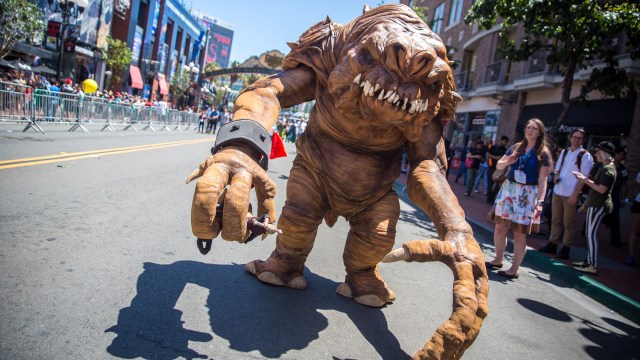
We’re extremely excited to reveal our big creature project at San Diego Comic-Con: The Rancor! Effects artist Frank Ippolito designed and built this incredibly-detailed foam costume in less than a month, based on references from an original test costume used for the Star Wars: Return of the Jedi production team. In the coming weeks, we’ll show you how this Rancor was built, and teach you some of the processes Frank and his team used to make a wearable foam creature costume! (Thanks to Model-Space.com for supporting this project. Check out the Millennium Falcon model kit here.)
Shot and edited by Joey Fameli
Bits to Atoms: 3D Printing a Mercury Capsule Miniature
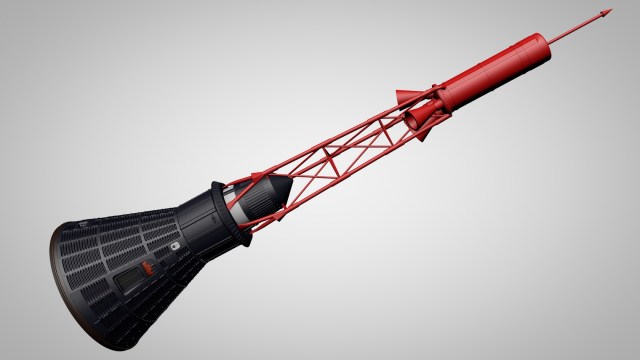
Shortly before this past Christmas, I was contacted by Lauren Oliver, an extremely polite gentleman who had discovered my Buckaroo Banzai Jet Car on The Replica Prop Forum. He reached out to inquire if I would be interested in building a NASA Mercury space capsule for a short film he was writing and directing. I was most definitely interested.
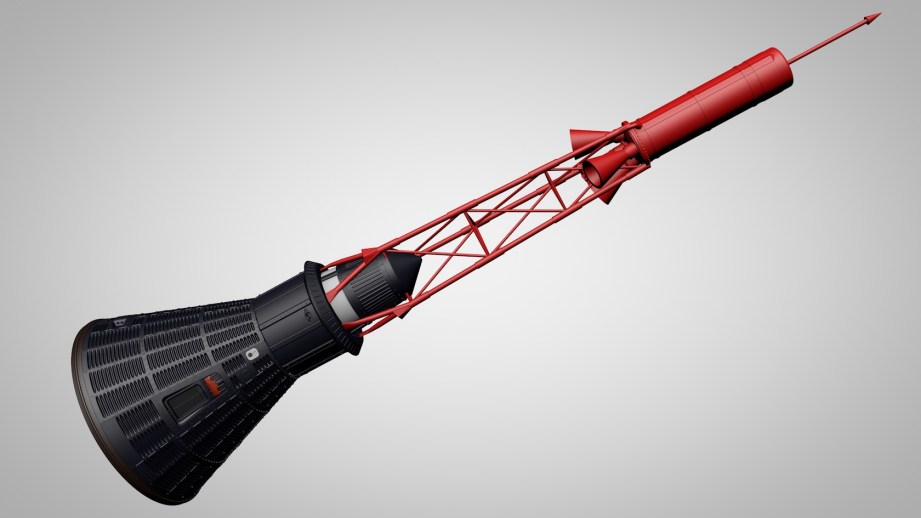
Lauren’s short film, “T-Minus“, is a fictional account of the 7th manned Mercury mission, which was cancelled in favor of moving on to the Gemini program. His plan was to shoot on 35mm film, using nothing but scale models and practical effects. My background is in film production–almost everything I ever shot was on film and I grew up in the 70’s and 80’s (the heyday of practical effects). This was my kind of project!
For the film, Lauren intended to build a 1/24 scale Atlas rocket, including the launch gantry (more on this later) but needed the capsule and other parts made. My initial response was, “not to put myself out of a job, but can’t you just use an existing model kit?”–I figured there must be a ton to choose from. There are, in fact; that was his original intention, but none were detailed enough and/or at the right scale.
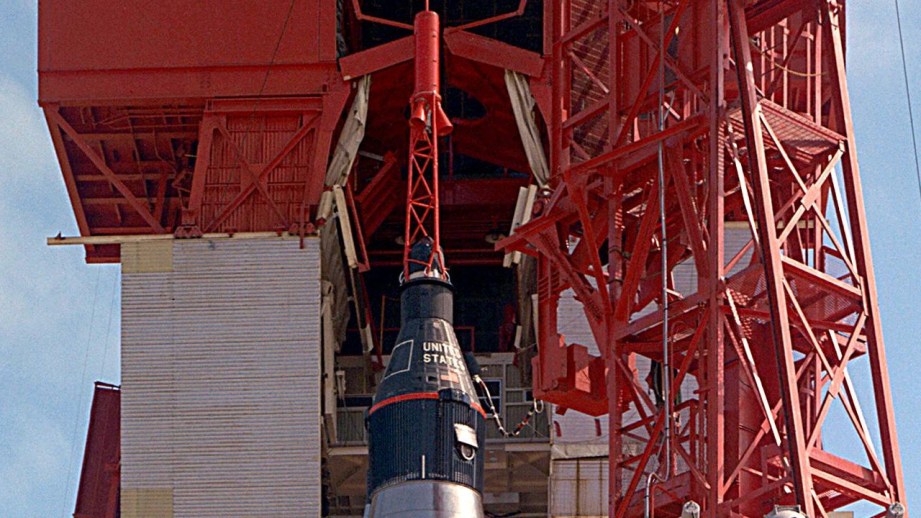
I have to confess, I know more about Star Wars ships than I do about our real-life NASA fleet and there are as many Mercury capsule versions as there are TIE-Fighter models. So, I was very pleased when Lauren presented me tons of reference photos, blueprints and detailed the differences between them all — he knew his stuff. Interestingly enough, at the time he was not aware of Tested and all the space goodness that goes down here–but I made sure to fill him in. My job was to build the capsule, the escape tower (the red rocket assembly at top), and the adapter, which attached the whole thing to the Atlas rocket.
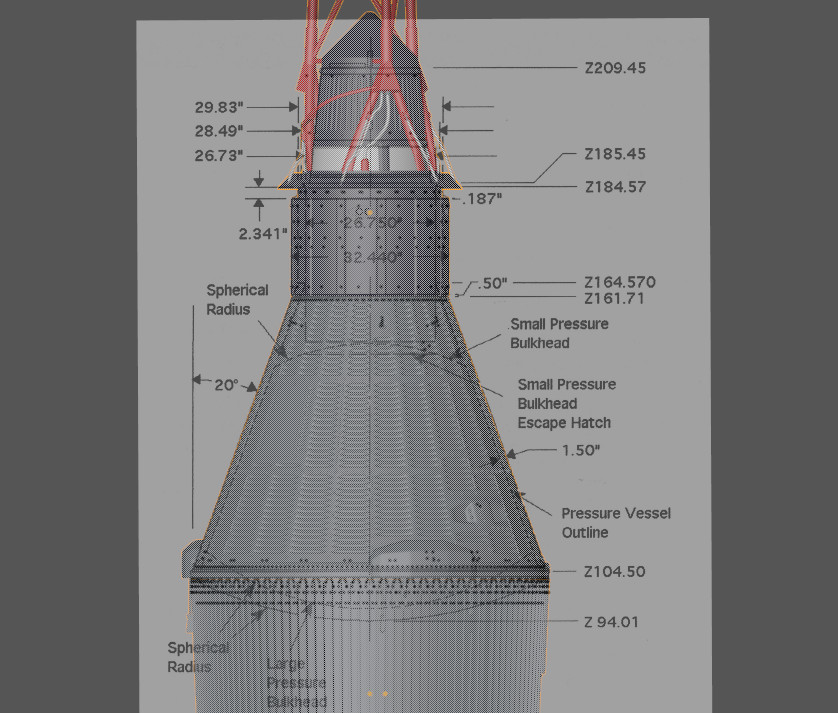 NASA blueprints made modeling easier
NASA blueprints made modeling easier
With my hoard of blueprints and photos, I imported diagrams to Cinema 4D to use as building reference. I modeled everything at full scale so I could simply enter direct measurements from the blueprints and scale down the finished model for printing. But, even with the blueprints, there were many details that had no dimensions listed. Rather than trying to estimate measurements using Photoshop, as I did for Adam’s Hellboy Motivator, I decided to find a physical reference. I ended up with an Atomic City Model Engineering 1/12 scale kit, that enthusiasts indicated was the one to buy. It turned out to be the exact one Lauren had originally intended to use for his rocket, until he realized that at 1/12th scale the entire structure would be over 14 feet tall!
Having a physical reference to work from was a great help and aided in not only measurements, but part layout, as it wasn’t always clear from the blueprints. I could simply take caliper measurements from the kit and scale them up for the 3D model.
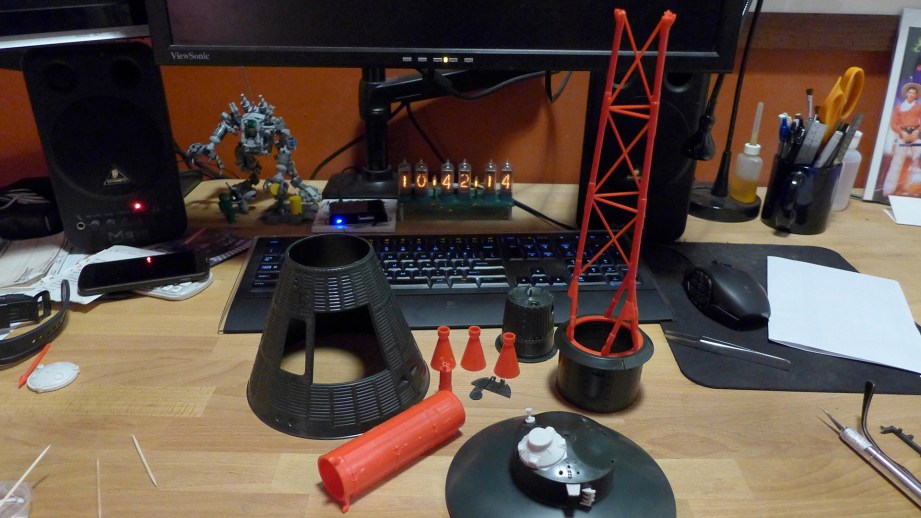 Having a physical reference from an existing model kit was a nice change of pace for this project.
Having a physical reference from an existing model kit was a nice change of pace for this project.
With so many parts, it can be hard to decide where to start. Sometimes, I will pick an easy bit to get in the groove. But lately, I have been picking problematic pieces first. It can be a frustrating way to start, but once that hurdle is cleared, you know everything else will be easier. Another good reason for this approach is, sometimes, you discover that a problematic piece will require rebuilding parts you have already done. Getting the troublemaker out of the way early can save work down the line.
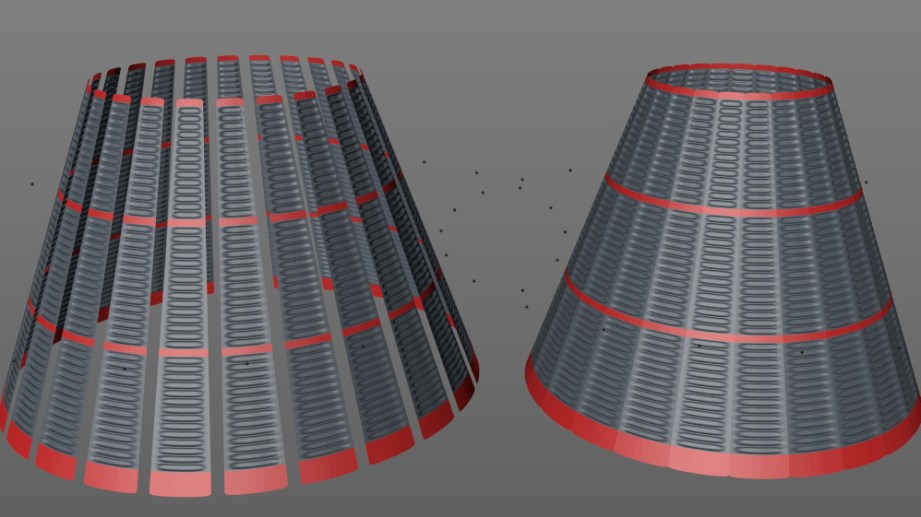 A single panel is made and put into an array.
A single panel is made and put into an array.
I immediately knew my problem child was going to be the corrugations on the capsule. It’s the capsule’s most distinctive feature. There’s lot’s of them and they had to be perfect, or the capsule wouldn’t look right. I lost track of how many iterations I did (at least six) before finding the ‘easiest’ way to build the corrugated panels. Ultimately, I designed a base panel that could be duplicated in an array and used for most sections, to make up the skin of the capsule. After all the prototypes, I built the first ‘official’ panel, only to discover I miscounted and didn’t have enough rows of corrugation. Sigh.
Sometimes, you can go back and fix these mistakes, but often it’s easier and faster to just build it again. Each version comes together faster than the last, and even though it was tedious, it was true in this case. With the fixed panel as a base, I made the array and edited each panel to match the blueprints and then finally joined them together to make a complete body.
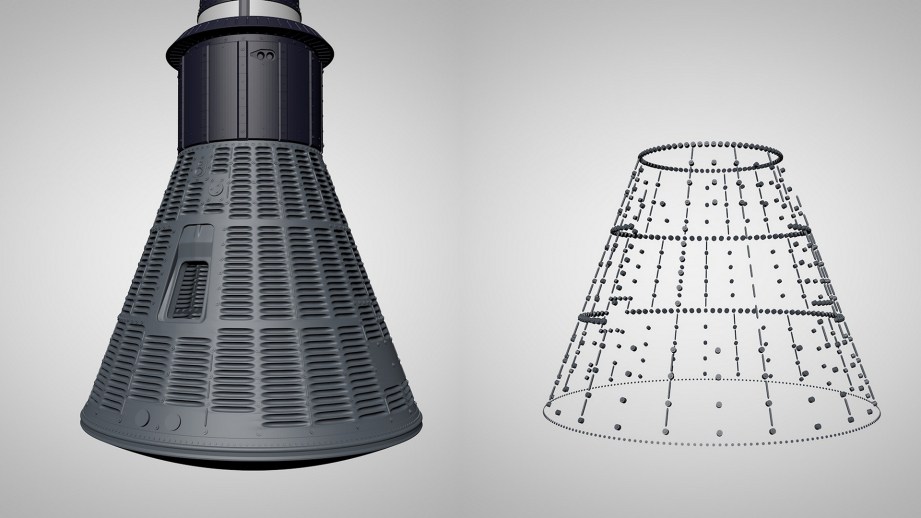 Almost 1000 rivets later.
Almost 1000 rivets later.
Once the capsule base was done, all the details had to be built–a lot of them. This was different than something like Adam’s Hellboy Motivator, which didn’t have as many details, but had to function mechanically. Most of my time with the Motivator was figuring out how things would go together and work. The capsule wouldn’t have many separate parts to assemble, but each part had a ton of detail that needed to be built accurately, like the almost 1,000 rivets on the finished model. While I could use functions within the modeling program to make this easier, I still had to manually place each column and row. I also had to figure out how the parts would assemble, keeping in mind how they would attach to the rocket body that Lauren was building. There was a constant stream of emails confirming details, assembly methods and most importantly the scale of parts. Since many measurements came from using callipers on the 1/12 model, slight discrepancies could happen that became large ones when scaling up and down.
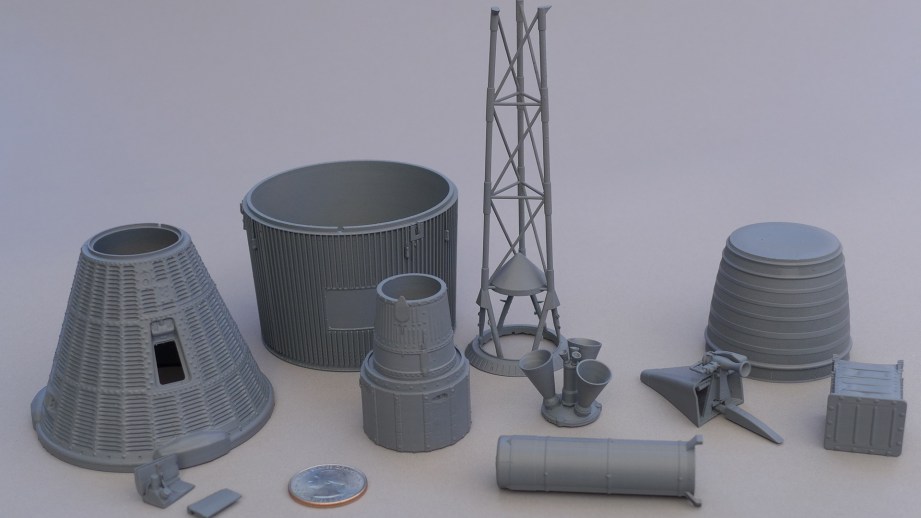
When building the Motivator, anything that was an individual part on the original, was modeled and printed the same. The challenge with the Mercury project was deciding what should be a separate piece and thinking ahead during the modeling process to accommodate that. The breakdown was determined between consulting with Lauren on how it needed to attach to the rocket body, and the best way to print it, considering cost and clean up.
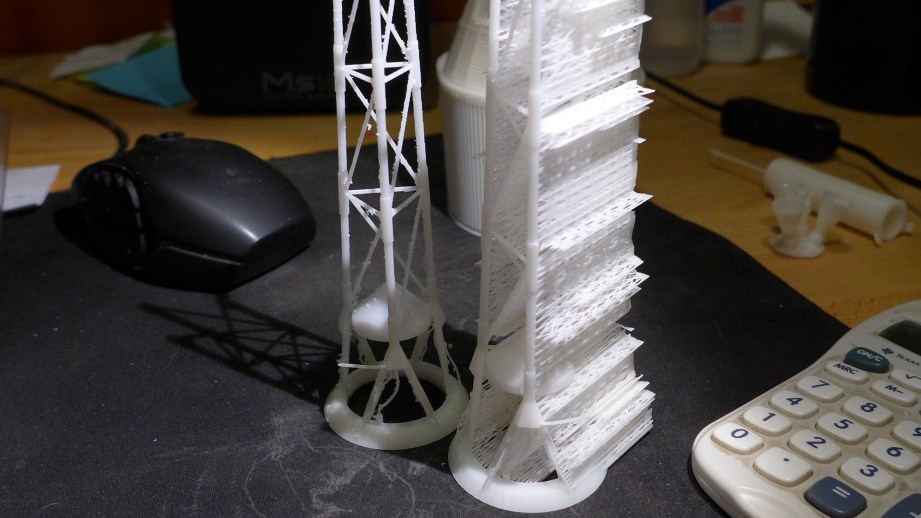 Cleaning tower supports was a challenge.
Cleaning tower supports was a challenge.
I designed almost all the parts to be hollow, as it greatly reduces the printing cost. The body of the escape tower (red structure on top of the capsule) was designed to print solo because the printer supports would be tedious to clean off. For the rest of the parts, I designed a slot and key to align them properly when assembled.
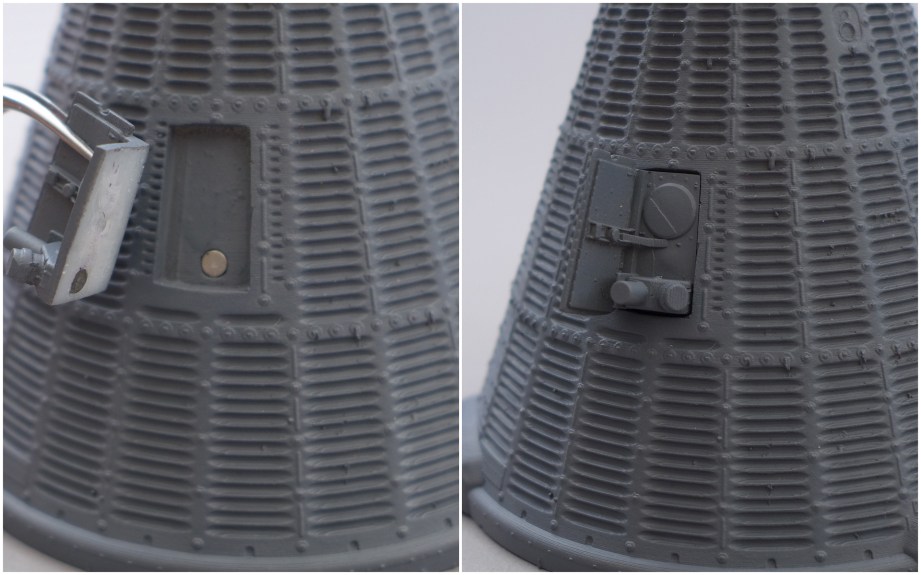 Magnets attach removable umbilical connections
Magnets attach removable umbilical connections
The finished assembly stands slightly over 14″ tall and has a removable hatch that can be replaced with the launch umbilical attachment via neodymium magnets. I also ended up building the main and vernier engines to be used on the rocket body and CNC bucks for vacuum forming the engine fairings.
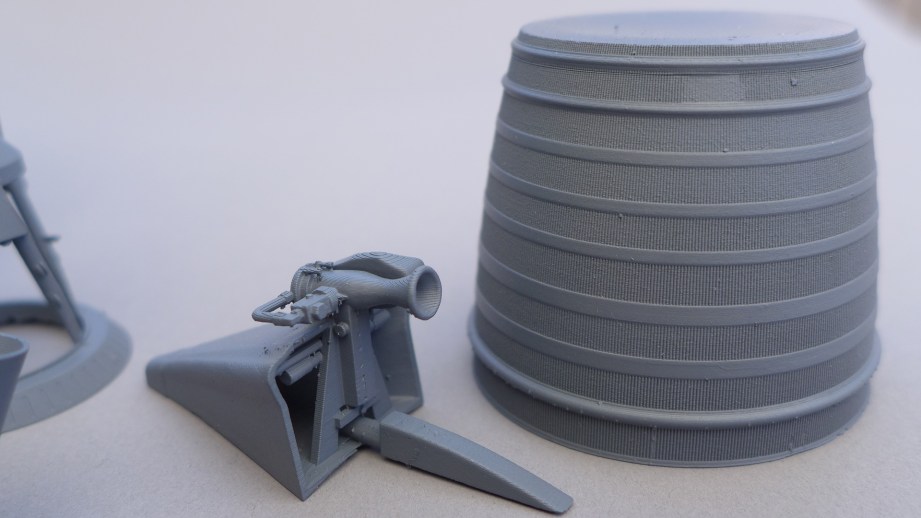 Resolution good enough to show ribbing – notice you can still see layers
Resolution good enough to show ribbing – notice you can still see layers
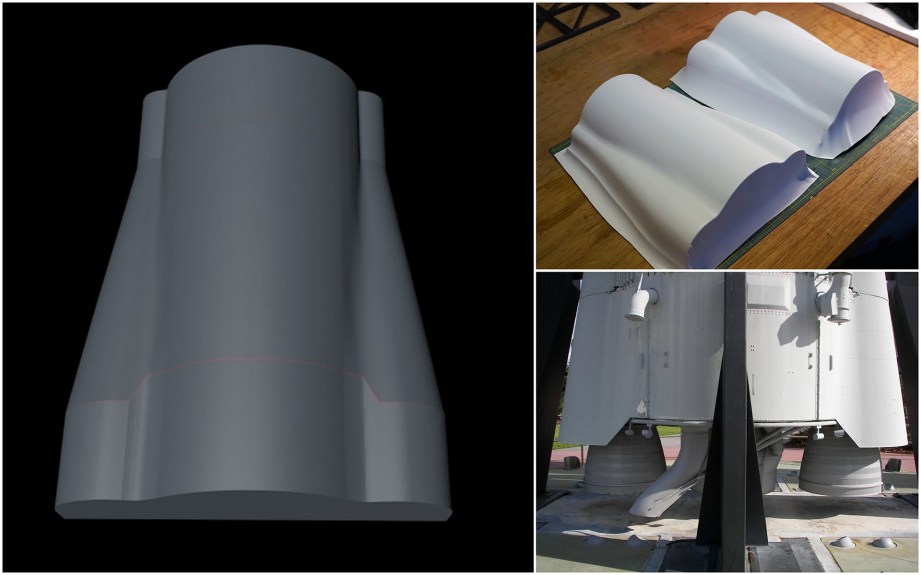 3D model used to CNC bucks for vacuum forming.
3D model used to CNC bucks for vacuum forming.
 Adds-ons for 1/12 model kit.
Adds-ons for 1/12 model kit.
Additional compartments were built to attach to the 1/12 scale Atomic City Engineering model. Lauren intends to use it as a prop in the film and the compartments were needed to make it accurate to the Mercury 10 mission capsule.
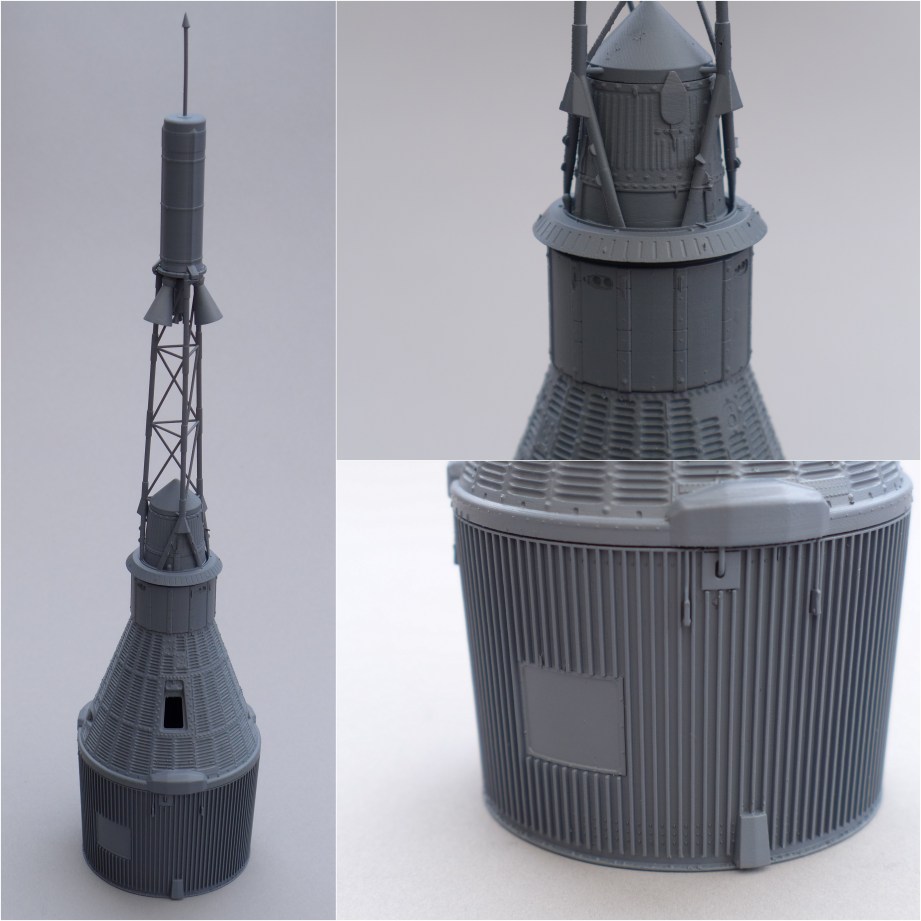
Over 160 hours and almost 1,000 rivets later, this has been one of the most intricate projects I have tackled and couldn’t be more pleased with the results. We will be doing a few hand-painted 1/48th capsule prints as one of many “T-Minus” Kickstarter rewards. Stick around for a write-up on the physical build of the Atlas rocket for this film!
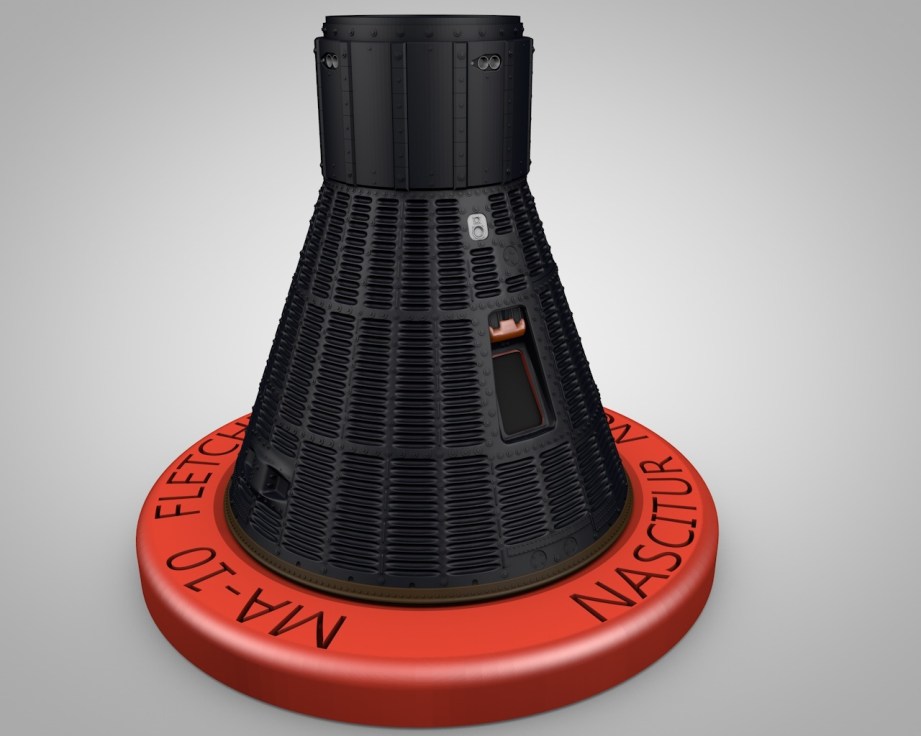
You can learn more about the film itself and even help it happen by checking out the “T-Minus” Kickstarter going on through the end of the month.
Photo Gallery: Adam Incognito with Astronaut Chris Hadfield














































Photo Gallery: Adam Incognito with Astronaut Chris Hadfield
Photo Gallery: hadfield_incognito_005
Here are some photos I took of Adam and Commander Chris Hadfield prepping for their Comic-Con incognito walk, roaming the convention show floor, and randomly bumping into “The Martian” author Andy Weir! You can actually see the exact moment when Andy realizes that the two 2001: A Space Odyssey astronauts must be Adam and Chris!Photo Gallery: Adam Incognito with Astronaut Chris Hadfield
Photo Gallery: hadfield_incognito_004
Here are some photos I took of Adam and Commander Chris Hadfield prepping for their Comic-Con incognito walk, roaming the convention show floor, and randomly bumping into “The Martian” author Andy Weir! You can actually see the exact moment when Andy realizes that the two 2001: A Space Odyssey astronauts must be Adam and Chris!Photo Gallery: Adam Incognito with Astronaut Chris Hadfield
Photo Gallery: hadfield_incognito_006
Here are some photos I took of Adam and Commander Chris Hadfield prepping for their Comic-Con incognito walk, roaming the convention show floor, and randomly bumping into “The Martian” author Andy Weir! You can actually see the exact moment when Andy realizes that the two 2001: A Space Odyssey astronauts must be Adam and Chris!Photo Gallery: Adam Incognito with Astronaut Chris Hadfield
Photo Gallery: hadfield_incognito_007
Here are some photos I took of Adam and Commander Chris Hadfield prepping for their Comic-Con incognito walk, roaming the convention show floor, and randomly bumping into “The Martian” author Andy Weir! You can actually see the exact moment when Andy realizes that the two 2001: A Space Odyssey astronauts must be Adam and Chris!Photo Gallery: Adam Incognito with Astronaut Chris Hadfield
Photo Gallery: hadfield_incognito_008
Here are some photos I took of Adam and Commander Chris Hadfield prepping for their Comic-Con incognito walk, roaming the convention show floor, and randomly bumping into “The Martian” author Andy Weir! You can actually see the exact moment when Andy realizes that the two 2001: A Space Odyssey astronauts must be Adam and Chris!Photo Gallery: Adam Incognito with Astronaut Chris Hadfield
Photo Gallery: hadfield_incognito_009
Here are some photos I took of Adam and Commander Chris Hadfield prepping for their Comic-Con incognito walk, roaming the convention show floor, and randomly bumping into “The Martian” author Andy Weir! You can actually see the exact moment when Andy realizes that the two 2001: A Space Odyssey astronauts must be Adam and Chris!Photo Gallery: Adam Incognito with Astronaut Chris Hadfield
Photo Gallery: hadfield_incognito_010
Here are some photos I took of Adam and Commander Chris Hadfield prepping for their Comic-Con incognito walk, roaming the convention show floor, and randomly bumping into “The Martian” author Andy Weir! You can actually see the exact moment when Andy realizes that the two 2001: A Space Odyssey astronauts must be Adam and Chris!Photo Gallery: Adam Incognito with Astronaut Chris Hadfield
Photo Gallery: hadfield_incognito_011
Here are some photos I took of Adam and Commander Chris Hadfield prepping for their Comic-Con incognito walk, roaming the convention show floor, and randomly bumping into “The Martian” author Andy Weir! You can actually see the exact moment when Andy realizes that the two 2001: A Space Odyssey astronauts must be Adam and Chris!Photo Gallery: Adam Incognito with Astronaut Chris Hadfield
Photo Gallery: hadfield_incognito_012
Here are some photos I took of Adam and Commander Chris Hadfield prepping for their Comic-Con incognito walk, roaming the convention show floor, and randomly bumping into “The Martian” author Andy Weir! You can actually see the exact moment when Andy realizes that the two 2001: A Space Odyssey astronauts must be Adam and Chris!Photo Gallery: Adam Incognito with Astronaut Chris Hadfield
Photo Gallery: hadfield_incognito_013
Here are some photos I took of Adam and Commander Chris Hadfield prepping for their Comic-Con incognito walk, roaming the convention show floor, and randomly bumping into “The Martian” author Andy Weir! You can actually see the exact moment when Andy realizes that the two 2001: A Space Odyssey astronauts must be Adam and Chris!Photo Gallery: Adam Incognito with Astronaut Chris Hadfield
Photo Gallery: hadfield_incognito_014
Here are some photos I took of Adam and Commander Chris Hadfield prepping for their Comic-Con incognito walk, roaming the convention show floor, and randomly bumping into “The Martian” author Andy Weir! You can actually see the exact moment when Andy realizes that the two 2001: A Space Odyssey astronauts must be Adam and Chris!Photo Gallery: Adam Incognito with Astronaut Chris Hadfield
Photo Gallery: hadfield_incognito_015
Here are some photos I took of Adam and Commander Chris Hadfield prepping for their Comic-Con incognito walk, roaming the convention show floor, and randomly bumping into “The Martian” author Andy Weir! You can actually see the exact moment when Andy realizes that the two 2001: A Space Odyssey astronauts must be Adam and Chris!Photo Gallery: Adam Incognito with Astronaut Chris Hadfield
Photo Gallery: hadfield_incognito_016
Here are some photos I took of Adam and Commander Chris Hadfield prepping for their Comic-Con incognito walk, roaming the convention show floor, and randomly bumping into “The Martian” author Andy Weir! You can actually see the exact moment when Andy realizes that the two 2001: A Space Odyssey astronauts must be Adam and Chris!Photo Gallery: Adam Incognito with Astronaut Chris Hadfield
Photo Gallery: hadfield_incognito_017
Here are some photos I took of Adam and Commander Chris Hadfield prepping for their Comic-Con incognito walk, roaming the convention show floor, and randomly bumping into “The Martian” author Andy Weir! You can actually see the exact moment when Andy realizes that the two 2001: A Space Odyssey astronauts must be Adam and Chris!Photo Gallery: Adam Incognito with Astronaut Chris Hadfield
Photo Gallery: hadfield_incognito_018
Here are some photos I took of Adam and Commander Chris Hadfield prepping for their Comic-Con incognito walk, roaming the convention show floor, and randomly bumping into “The Martian” author Andy Weir! You can actually see the exact moment when Andy realizes that the two 2001: A Space Odyssey astronauts must be Adam and Chris!Photo Gallery: Adam Incognito with Astronaut Chris Hadfield
Photo Gallery: hadfield_incognito_019
Here are some photos I took of Adam and Commander Chris Hadfield prepping for their Comic-Con incognito walk, roaming the convention show floor, and randomly bumping into “The Martian” author Andy Weir! You can actually see the exact moment when Andy realizes that the two 2001: A Space Odyssey astronauts must be Adam and Chris!Photo Gallery: Adam Incognito with Astronaut Chris Hadfield
Photo Gallery: hadfield_incognito_020
Here are some photos I took of Adam and Commander Chris Hadfield prepping for their Comic-Con incognito walk, roaming the convention show floor, and randomly bumping into “The Martian” author Andy Weir! You can actually see the exact moment when Andy realizes that the two 2001: A Space Odyssey astronauts must be Adam and Chris!Photo Gallery: Adam Incognito with Astronaut Chris Hadfield
Photo Gallery: hadfield_incognito_021
Here are some photos I took of Adam and Commander Chris Hadfield prepping for their Comic-Con incognito walk, roaming the convention show floor, and randomly bumping into “The Martian” author Andy Weir! You can actually see the exact moment when Andy realizes that the two 2001: A Space Odyssey astronauts must be Adam and Chris!Photo Gallery: Adam Incognito with Astronaut Chris Hadfield
Photo Gallery: hadfield_incognito_022
Here are some photos I took of Adam and Commander Chris Hadfield prepping for their Comic-Con incognito walk, roaming the convention show floor, and randomly bumping into “The Martian” author Andy Weir! You can actually see the exact moment when Andy realizes that the two 2001: A Space Odyssey astronauts must be Adam and Chris!Photo Gallery: Adam Incognito with Astronaut Chris Hadfield
Photo Gallery: hadfield_incognito_023
Here are some photos I took of Adam and Commander Chris Hadfield prepping for their Comic-Con incognito walk, roaming the convention show floor, and randomly bumping into “The Martian” author Andy Weir! You can actually see the exact moment when Andy realizes that the two 2001: A Space Odyssey astronauts must be Adam and Chris!Photo Gallery: Adam Incognito with Astronaut Chris Hadfield
Photo Gallery: hadfield_incognito_024
Here are some photos I took of Adam and Commander Chris Hadfield prepping for their Comic-Con incognito walk, roaming the convention show floor, and randomly bumping into “The Martian” author Andy Weir! You can actually see the exact moment when Andy realizes that the two 2001: A Space Odyssey astronauts must be Adam and Chris!Photo Gallery: Adam Incognito with Astronaut Chris Hadfield
Photo Gallery: hadfield_incognito_025
Here are some photos I took of Adam and Commander Chris Hadfield prepping for their Comic-Con incognito walk, roaming the convention show floor, and randomly bumping into “The Martian” author Andy Weir! You can actually see the exact moment when Andy realizes that the two 2001: A Space Odyssey astronauts must be Adam and Chris!Photo Gallery: Adam Incognito with Astronaut Chris Hadfield
Photo Gallery: hadfield_incognito_026
Here are some photos I took of Adam and Commander Chris Hadfield prepping for their Comic-Con incognito walk, roaming the convention show floor, and randomly bumping into “The Martian” author Andy Weir! You can actually see the exact moment when Andy realizes that the two 2001: A Space Odyssey astronauts must be Adam and Chris!Photo Gallery: Adam Incognito with Astronaut Chris Hadfield
Photo Gallery: hadfield_incognito_027
Here are some photos I took of Adam and Commander Chris Hadfield prepping for their Comic-Con incognito walk, roaming the convention show floor, and randomly bumping into “The Martian” author Andy Weir! You can actually see the exact moment when Andy realizes that the two 2001: A Space Odyssey astronauts must be Adam and Chris!Photo Gallery: Adam Incognito with Astronaut Chris Hadfield
Photo Gallery: hadfield_incognito_028
Here are some photos I took of Adam and Commander Chris Hadfield prepping for their Comic-Con incognito walk, roaming the convention show floor, and randomly bumping into “The Martian” author Andy Weir! You can actually see the exact moment when Andy realizes that the two 2001: A Space Odyssey astronauts must be Adam and Chris!Photo Gallery: Adam Incognito with Astronaut Chris Hadfield
Photo Gallery: hadfield_incognito_029
Here are some photos I took of Adam and Commander Chris Hadfield prepping for their Comic-Con incognito walk, roaming the convention show floor, and randomly bumping into “The Martian” author Andy Weir! You can actually see the exact moment when Andy realizes that the two 2001: A Space Odyssey astronauts must be Adam and Chris!Photo Gallery: Adam Incognito with Astronaut Chris Hadfield
Photo Gallery: hadfield_incognito_030
Here are some photos I took of Adam and Commander Chris Hadfield prepping for their Comic-Con incognito walk, roaming the convention show floor, and randomly bumping into “The Martian” author Andy Weir! You can actually see the exact moment when Andy realizes that the two 2001: A Space Odyssey astronauts must be Adam and Chris!Photo Gallery: Adam Incognito with Astronaut Chris Hadfield
Photo Gallery: hadfield_incognito_031
Here are some photos I took of Adam and Commander Chris Hadfield prepping for their Comic-Con incognito walk, roaming the convention show floor, and randomly bumping into “The Martian” author Andy Weir! You can actually see the exact moment when Andy realizes that the two 2001: A Space Odyssey astronauts must be Adam and Chris!Photo Gallery: Adam Incognito with Astronaut Chris Hadfield
Photo Gallery: hadfield_incognito_032
Here are some photos I took of Adam and Commander Chris Hadfield prepping for their Comic-Con incognito walk, roaming the convention show floor, and randomly bumping into “The Martian” author Andy Weir! You can actually see the exact moment when Andy realizes that the two 2001: A Space Odyssey astronauts must be Adam and Chris!Photo Gallery: Adam Incognito with Astronaut Chris Hadfield
Photo Gallery: hadfield_incognito_033
Here are some photos I took of Adam and Commander Chris Hadfield prepping for their Comic-Con incognito walk, roaming the convention show floor, and randomly bumping into “The Martian” author Andy Weir! You can actually see the exact moment when Andy realizes that the two 2001: A Space Odyssey astronauts must be Adam and Chris!Photo Gallery: Adam Incognito with Astronaut Chris Hadfield
Photo Gallery: hadfield_incognito_034
Here are some photos I took of Adam and Commander Chris Hadfield prepping for their Comic-Con incognito walk, roaming the convention show floor, and randomly bumping into “The Martian” author Andy Weir! You can actually see the exact moment when Andy realizes that the two 2001: A Space Odyssey astronauts must be Adam and Chris!Photo Gallery: Adam Incognito with Astronaut Chris Hadfield
Photo Gallery: hadfield_incognito_035
Here are some photos I took of Adam and Commander Chris Hadfield prepping for their Comic-Con incognito walk, roaming the convention show floor, and randomly bumping into “The Martian” author Andy Weir! You can actually see the exact moment when Andy realizes that the two 2001: A Space Odyssey astronauts must be Adam and Chris!Photo Gallery: Adam Incognito with Astronaut Chris Hadfield
Photo Gallery: hadfield_incognito_036
Here are some photos I took of Adam and Commander Chris Hadfield prepping for their Comic-Con incognito walk, roaming the convention show floor, and randomly bumping into “The Martian” author Andy Weir! You can actually see the exact moment when Andy realizes that the two 2001: A Space Odyssey astronauts must be Adam and Chris!Photo Gallery: Adam Incognito with Astronaut Chris Hadfield
Photo Gallery: hadfield_incognito_037
Here are some photos I took of Adam and Commander Chris Hadfield prepping for their Comic-Con incognito walk, roaming the convention show floor, and randomly bumping into “The Martian” author Andy Weir! You can actually see the exact moment when Andy realizes that the two 2001: A Space Odyssey astronauts must be Adam and Chris!Photo Gallery: Adam Incognito with Astronaut Chris Hadfield
Photo Gallery: hadfield_incognito_038
Here are some photos I took of Adam and Commander Chris Hadfield prepping for their Comic-Con incognito walk, roaming the convention show floor, and randomly bumping into “The Martian” author Andy Weir! You can actually see the exact moment when Andy realizes that the two 2001: A Space Odyssey astronauts must be Adam and Chris!Photo Gallery: Adam Incognito with Astronaut Chris Hadfield
Photo Gallery: hadfield_incognito_039
Here are some photos I took of Adam and Commander Chris Hadfield prepping for their Comic-Con incognito walk, roaming the convention show floor, and randomly bumping into “The Martian” author Andy Weir! You can actually see the exact moment when Andy realizes that the two 2001: A Space Odyssey astronauts must be Adam and Chris!Photo Gallery: Adam Incognito with Astronaut Chris Hadfield
Photo Gallery: hadfield_incognito_001
Here are some photos I took of Adam and Commander Chris Hadfield prepping for their Comic-Con incognito walk, roaming the convention show floor, and randomly bumping into “The Martian” author Andy Weir! You can actually see the exact moment when Andy realizes that the two 2001: A Space Odyssey astronauts must be Adam and Chris!Photo Gallery: Adam Incognito with Astronaut Chris Hadfield
Photo Gallery: hadfield_incognito_002
Here are some photos I took of Adam and Commander Chris Hadfield prepping for their Comic-Con incognito walk, roaming the convention show floor, and randomly bumping into “The Martian” author Andy Weir! You can actually see the exact moment when Andy realizes that the two 2001: A Space Odyssey astronauts must be Adam and Chris!Photo Gallery: Adam Incognito with Astronaut Chris Hadfield
Photo Gallery: hadfield_incognito_003
Here are some photos I took of Adam and Commander Chris Hadfield prepping for their Comic-Con incognito walk, roaming the convention show floor, and randomly bumping into “The Martian” author Andy Weir! You can actually see the exact moment when Andy realizes that the two 2001: A Space Odyssey astronauts must be Adam and Chris!Photo Gallery: Adam Incognito with Astronaut Chris Hadfield
Photo Gallery: hadfield_incognito_040
Here are some photos I took of Adam and Commander Chris Hadfield prepping for their Comic-Con incognito walk, roaming the convention show floor, and randomly bumping into “The Martian” author Andy Weir! You can actually see the exact moment when Andy realizes that the two 2001: A Space Odyssey astronauts must be Adam and Chris!Photo Gallery: Adam Incognito with Astronaut Chris Hadfield
Photo Gallery: hadfield_incognito_041
Here are some photos I took of Adam and Commander Chris Hadfield prepping for their Comic-Con incognito walk, roaming the convention show floor, and randomly bumping into “The Martian” author Andy Weir! You can actually see the exact moment when Andy realizes that the two 2001: A Space Odyssey astronauts must be Adam and Chris!Photo Gallery: Adam Incognito with Astronaut Chris Hadfield
Photo Gallery: hadfield_incognito_042
Here are some photos I took of Adam and Commander Chris Hadfield prepping for their Comic-Con incognito walk, roaming the convention show floor, and randomly bumping into “The Martian” author Andy Weir! You can actually see the exact moment when Andy realizes that the two 2001: A Space Odyssey astronauts must be Adam and Chris!Photo Gallery: Adam Incognito with Astronaut Chris Hadfield
Photo Gallery: hadfield_incognito_043
Here are some photos I took of Adam and Commander Chris Hadfield prepping for their Comic-Con incognito walk, roaming the convention show floor, and randomly bumping into “The Martian” author Andy Weir! You can actually see the exact moment when Andy realizes that the two 2001: A Space Odyssey astronauts must be Adam and Chris!Photo Gallery: Adam Incognito with Astronaut Chris Hadfield
Photo Gallery: hadfield_incognito_044
Here are some photos I took of Adam and Commander Chris Hadfield prepping for their Comic-Con incognito walk, roaming the convention show floor, and randomly bumping into “The Martian” author Andy Weir! You can actually see the exact moment when Andy realizes that the two 2001: A Space Odyssey astronauts must be Adam and Chris!Tested Builds: Studio Scale Millennium Falcon, Part 5
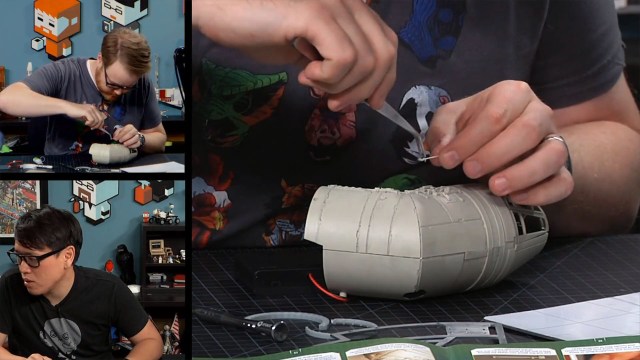
Bonus episode! We actually had one more episode of our Millennium Falcon build last week, but didn’t get a chance to post it while we were at Comic-Con. So here it is! Let’s see how those greeblies get attached to the cockpit of this model. If you’re not a member and want to support us, please consider signing up for a Tested Premium Membership here! Everyone who signs up this month gets this year’s limited-edition poster designed by Adam!
Comic-Con and Commander Chris Hadfield – 7/14/2015

Adam Savage Incognito at Comic-Con 2015 (with Astronaut Chris Hadfield!)
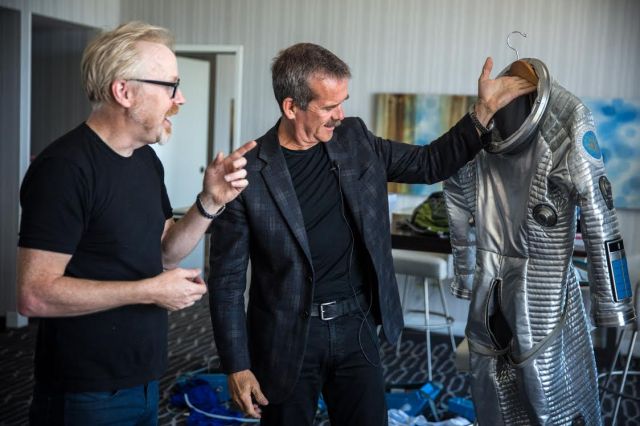
Every year, Adam Savage walks the floor of Comic-Con incognito, hidden in plain sight. This year, he’s mixing things up with a joint-incognito walk with special guest Astronaut Chris Hadfield! Appropriately, Adam and Commander Hadfield cosplay as 2001: A Space Odyssey astronauts, complete with working active water-cooling systems in their spacesuits. And on the show floor, they unexpectedly run into a mutual friend…
Comic-Con 2015 Show Floor Walking Tour (Single Long Take)
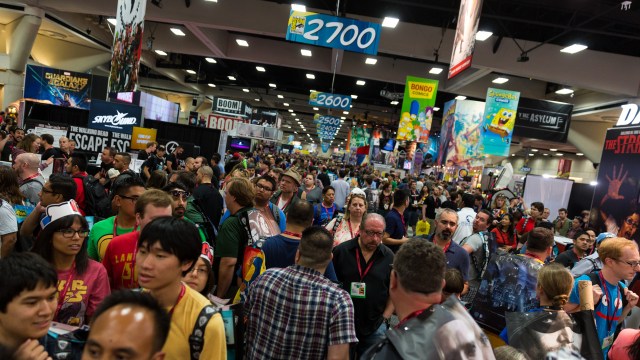
If you’ve never been to San Diego Comic-Con, it’s difficult to get a sense of just how massive and packed the convention floor really is. Using a stabilized camera on a handheld gimbal, we give you our walking tour of comic-con, shot in a single 20-minute long take! We wade through the crowd to show you how the convention is laid out, step into a few of our favorite booths, and run into a few friends!
Building Anovos’ Star Wars Shadowtrooper Kit (Part 1)
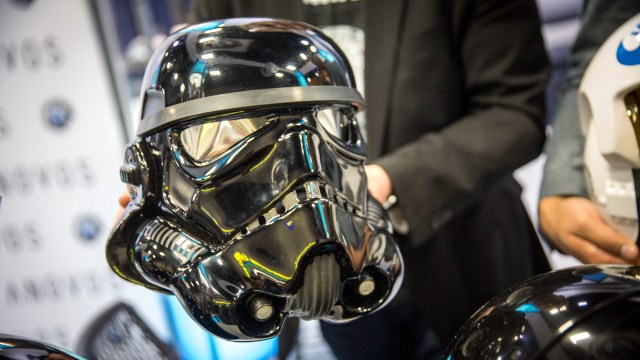
At Comic-Con 2015, we met up with Anovos, the makers of officially licensed Star Wars costumes and helmets. Among completed costumes, they’re releasing a D-I-Y kit for Stormtrooper armor (which includes a finished helmet). We get our hands on an early test Shadowtrooper kit from Anovos, and walk through the process of cleaning up the vacu-formed pieces with effects artist Frank Ippolito!
Shot and edited by Joey Fameli






